
MODEL
DIGITAL MULTIFUNCTIONAL
SYSTEM
OPERATION MANUAL

MODEL
DIGITAL MULTIFUNCTIONAL
SYSTEM
OPERATION MANUAL
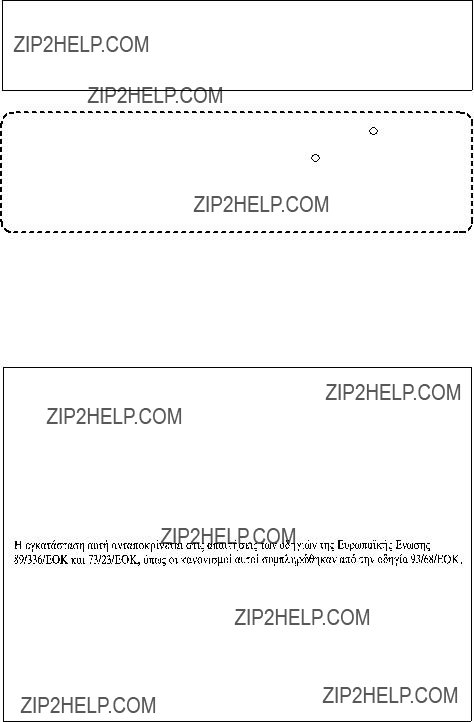
Do not make copies of anything which is prohibited from copying by law. The following items are normally prohibited from copying by national law. Other items may be prohibited by local law.
In some areas, the "POWER" switch positions are marked "I" and " " on the copier instead of "ON" and "OFF".
If your copier is so marked, please read "I" for "ON" and " " for "OFF".
Caution!
For a complete electrical disconnection, pull out the main plug.
The
This equipment complies with the requirements of Directives 89/336/EEC and 73/23/EEC as amended by 93/68/EEC.
Dieses Ger??t entspricht den Anforderungen der
Ce mat??riel r??pond aux exigences contenues dans les directives 89/336/CEE et 73/23/CEE modifi??es par la directive 93/68/CEE.
Dit apparaat voldoet aan de eisen van de richtlijnen 89/336/EEG en 73/23/EEG, gewijzigd door 93/68/EEG.
Dette udstyr overholder kravene i direktiv nr. 89/336/EEC og 73/23/EEC med till??g nr. 93/68/EEC.
Quest??? apparecchio ?? conforme ai requisiti delle direttive 89/336/EEC e 73/23/EEC, come emendata dalla direttiva 93/68/EEC.
Este equipamento obedece ??s exig??ncias das directivas 89/336/CEE e 73/23/CEE, na sua vers??o corrigida pela directiva 93/68/CEE.
Este aparato satisface las exigencias de las Directivas 89/336/CEE y 73/23/CEE, modificadas por medio de la 93/68/CEE.
Denna utrustning uppfyller kraven enligt riktlinjerna 89/336/EEC och 73/23/EEC s?? som kompletteras av 93/68/EEC.
Dette produktet oppfyller betingelsene i derektivene 89/336/EEC og 73/23/EEC i endringen 93/68/EEC.
T??m?? laite t??ytt???? direktiivien 89/336/EEC ja 73/23/EEC vaatimukset, joita on muutettu direktiivill?? 93/68/EEC.
The CE mark logo label is affixed on an equipment in case that the directives described in the above sentence are applicable to the product. (This sentence is not applicable in any country where the above directives are not required.)

CONTENTS
1

2

CAUTIONS
Caution label on the machine
The label (
 ) in the fusing area of the machine indicates the following:
) in the fusing area of the machine indicates the following:
 : Caution, risk of danger
: Caution, risk of danger  : Caution, hot surface
: Caution, hot surface
Cautions on using the machine
Follow the cautions below when using this machine.
 Warning:
Warning:
???The fusing area is hot. Exercise care in this area when removing misfed paper.
???Do not look directly at the light source. Doing so may damage your eyes.
???Do not switch the machine rapidly on and off. After turning the machine off, wait 10 to 15 seconds before turning it back on.
???Machine power must be turned off before installing any supplies.
 Caution:
Caution:
???Place the machine on a firm, level surface.
???Do not install the machine in a humid or dusty location.
???When the machine is not used for a long time, for example for consecutive holidays, turn the power switch off and remove the power cord from the outlet.
???When moving the machine, be sure to turn the power switch off and remove the power cord from the outlet.
???Do not cover the machine with a dust cover, cloth or plastic film while the power is on. Doing so may prevent heat radiation, damaging the machine.
???Use of controls or adjustments or performance of procedures other than those specified herein may result in hazardous radiation exposure.
???The
Important points when selecting an installation site
Do not install your machine in areas that are:
???damp, humid, or very dusty
???exposed to direct sunlight
???poorly ventilated
???subject to extreme temperature or humidity changes, e.g., near an air conditioner
or heater.
Be sure to allow the required space around the machine for servicing and proper ventilation.
3

Cautions on handling the machine
Be careful in handling the machine as follows to maintain the performance of this machine.
Do not drop the machine, subject it to shock or strike it against any object. Do not expose the drum cartridge to direct sunlight.
???Doing so will damage the surface (green portion) of the drum cartridge, causing smudges on copies.
Store spare supplies such as drum cartridges and TD cartridges in a dark place without removing from the package before use.
???If they are exposed to direct sunlight, smudges on copies may result.
Do not touch the surface (green portion) of the drum cartridge.
???Doing so will damage the surface of the cartridge, causing smudges on copies.
Cautions on laser
Trademark acknowledgements
???Microsoft?? Windows?? operating system is a trademark or copyright of Microsoft Corporation in the U.S.A. and other countries.
???Windows?? 95, Windows?? 98, Windows?? Me, Windows NT?? 4.0, Windows?? 2000, and Windows?? XP are trademarks or copyrights of Microsoft Corporation in the U.S.A. and other countries.
???IBM and PC/AT are trademarks of International Business Machines Corporation.
???Acrobat?? Reader Copyright?? 1987- 2002 Adobe Systems Incorporated. All rights reserved. Adobe, the Adobe logo, Acrobat, and the Acrobat logo are trademarks of Adobe Systems Incorporated.
???All other trademarks and copyrights are the property of their respective owners.
4

ENVIRONMENTAL INFORMATION
As an ENERGY STAR?? Partner, SHARP has determined that this product meets the ENERGY STAR?? guidelines for energy efficiency.
A small amount of ozone is produced within the unit during operation. The emission level is insufficient to cause any health hazard.
Note:
The present recommended long term exposure limit for ozone is 0.1ppm (0.2mg/m3) calculated as an 8hr.
However, since the small amount that is emitted may have an objectionable odor, it is advisable to place the unit in a ventilated area.
USB 2.0 compatible
When connecting the machine by USB 2.0
5

INTRODUCTION
Using the manual
This machine has been designed to provide convenient copying features in a minimum amount of office space and with maximum operational ease. To get full use of all machine features, be sure to familiarize yourself with this manual and the machine. For quick reference during machine use, keep this manual in a handy location.
About the operation manuals
The operation manuals for the machine are as follows:
Operation Manual (this manual)
Explains the machine and how to use it as a copier. Also explains how to install the software that allows the machine to be used as a printer and scanner for your computer.
Online Manual (on the accessory
This manual explains the procedures for using the machine as a printer or a scanner.
Operation Manual (for facsimile) (for models that have the fax function)
This manual explains the procedures for using the machine as a fax machine.
Conventions used in this manual and online manual
???The illustrations in this manual show the
???Where
???Illustrations of driver screens and other computer screens show the screens that appear in Windows XP Home Edition. Some of the names that appear in these illustrations may differ slightly from the screens that appear in other operating systems.
???The explanations in this manual assume that the person who will install the product and the users of the product have a working knowledge of Microsoft Windows.
???This operation manual refers to the Reversing Single Pass Feeder as the "RSPF".
???In this manual, the following icons are used to provide the user with information pertinent to the use of the machine.
Warning

 Caution
Caution
 Note
Note
Warns that injury may result if the contents of the warning are not properly followed.
Cautions that damage to the machine or one of its components may result if the contents of the caution are not properly followed.
Notes provide useful information on the specifications, functions, performance, and operation of the machine.
6

MAIN FEATURES
Copying speed is 15 copies per minute. This is ideal for business use and provides a big boost to workplace productivity.
*1
*2 "dpi" ("dots per inch") is unit that is used to measure resolution. Resolution indicates how much detail can be reproduced in a printed or scanned image.
???
???In addition to automatic exposure adjustment, two original modes can be selected: "TEXT" for
???The photo mode copying function allows clear copying of delicate halftone original images such as monochrome photos and color photos.
Enhanced copying features
???Zoom copies can be made from 25% to 400% in increments of 1%. (When the RSPF is being used, the zoom copy ratio range is 50% to 200%.)
???Continuous copying of up to 99 copies is possible.
???Sets of output can be offset from each other for easy separation (offset function).
???Sorting by sets is possible without the need for a sorter or other special device (Sort copy).
???Includes convenient features such as margin shift, 2 IN 1 copy, and automatic two- sided copying.
Sort copy
Scan once/Print many
???The machine is equipped with a memory buffer allowing the machine to scan an original once and make up to 99 copies of the scanned image. This improves workflow, reduces operating noise from the machine and reduces wear and tear on the scanning mechanism, which provides for a higher reliability.
LCD panel displays messages
The LCD panel displays messages that show function settings and the status of the machine.
7

Laser printer function
???Printer function
The accompanying printer driver can be installed to enable use of the machine as a printer.
???Network printer function
A LAN connector is provided as a standard feature that allows the machine to be used as a network printer.
Color scanner function
???The accompanying scanner driver can be installed and the machine connected to a computer using a USB cable to enable use as a scanner.
Environment and people friendly design
???Preheat mode and auto power
???A universal design has been implemented in the product whereby the height of the operation panel and shape of the keys are designed to be usable by as many people as possible.
8
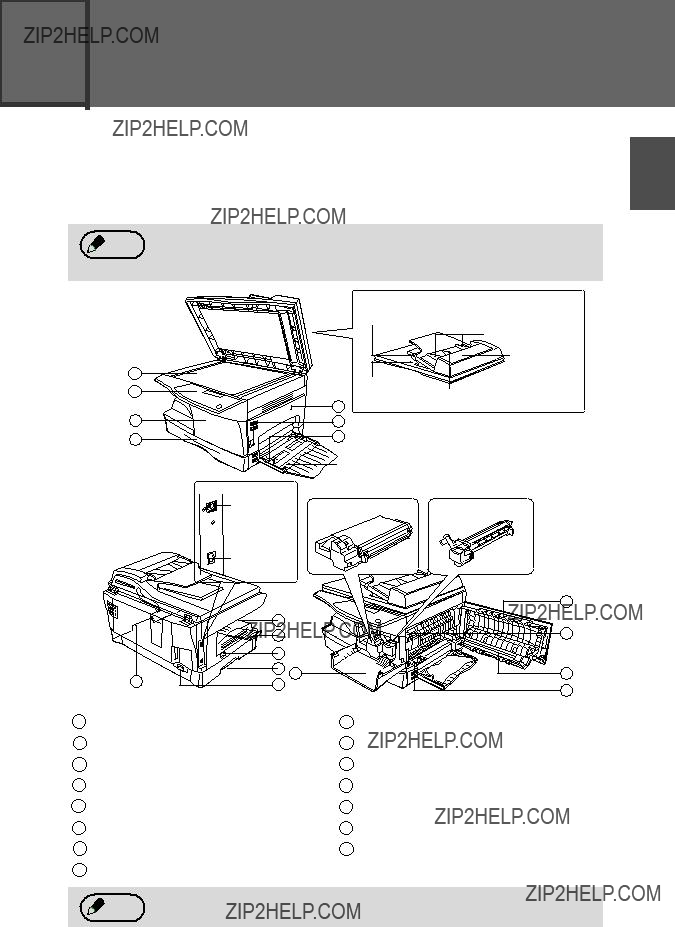
This chapter provides basic information that you should know before using the machine.
The following illustration shows the part names of the
The illustrations in this manual show the
basic operations are the same.
9

PREPARATIONS
Operation panel
1
MENU
1[MODE SELECT] key / Mode indicators
Press this key to select the mode. The indicator of the selected mode lights (copy, printer, scanner mode indicators).
2Display
This shows messages indicating the machine status and any problems that occur, as well as user programs and function setting menus.
3Numeric keys
Use these to enter the number of copies and other numerical settings.
The keys can also be used to select items in function setting menus.
4[CLEAR] key ( )
)
Use this to clear the set number of copies, as well as cancel a job that is in progress. When a setting menu appears, use this key to move back to the previous menu level.
5Power save indicator
This lights up when the power save function is activated.
6RSPF indicator
This lights up when an original is placed in the RSPF.
7Error indicator
This lights steadily or blinks when a paper misfeed or other error occurs.
6 7 8 9 10 11
8 [TRAY SELECT] key (  )
)
Use to select the paper tray that has the desired paper for copying.
9Tray location indicator
Indicates the selected paper tray. The indicator blinks when the tray is out of paper or is not closed.
10 [MENU] key
Press this key to select the paper size for copying, to configure a user program or to display the total count.
11 

 )] key
)] key
Use to copy both sides of an original.
1,2,3,
12
Press to select the sort function, 2 IN 1 copy function, or margin shift function.
13 [ ] key (
] key (  ), [
), [ ] key (
] key (  ), [OK] key
), [OK] key
Press the [ ] key (
] key (  ) or [
) or [ ] key
] key
(  )to select an item in a function setting menu.
)to select an item in a function setting menu.
Press the [OK] key to enter a selection.
14 [EXPOSURE ( 

 )] key
)] key
Use to switch from auto exposure adjustment to text mode or photo mode.
10

PREPARATIONS
1
15 [ZOOM] key
Press to select an enlargement or reduction ratio.
To select a preset ratio setting, press the [ZOOM] key and select the desired preset ratio. To select a ratio that is not preset, press the [ZOOM] key, select the preset ratio that is closest to the desired ratio, and then press the [ ] key (
] key (  ) or [
) or [ ] key (
] key (  ) to increase or decrease the ratio in increments of 1%.
) to increase or decrease the ratio in increments of 1%.
16[START] key ( ) / Ready indicator
) / Ready indicator
The ready indicator lights up when copying or scanning is possible.
To begin copying, press the [START]
key ( ).
).
The [START] key (  ) is also pressed to return to normal operation from auto power
) is also pressed to return to normal operation from auto power
17[CLEAR ALL] key ( )
)
This returns all functions to the default settings. When pressed in a setting menu, this returns the settings and display to the initial state.
18Shows the current copy ratio.
19Shows the selected paper size.
20Shows the number of copies that has been entered with the numeric keys.
21A checkmark " " appears when the exposure has been changed, or when
" appears when the exposure has been changed, or when
11
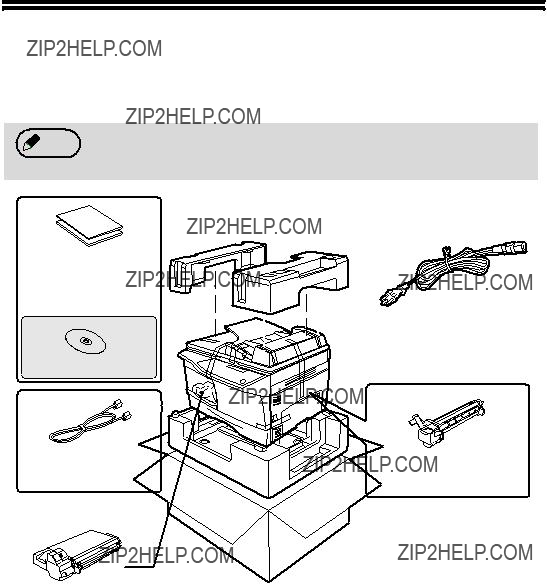
CHECKING PACKED COMPONENTS AND
ACCESSORIES
Open the carton and check if the following components and accessories are included.
If anything is missing or damaged, contact your authorized service representative.
??? Operation manual
??? Operation manual (For Facsimile)
Software
TD cartridge
12

PREPARING THE MACHINE FOR INSTALLATION
1 Be sure to hold the handles on both sides of the machine to unpack the machine and carry it to the installation location.
1
2 Remove all pieces of tape shown in the illustration below and then open the RSPF and remove the protective materials. Take out the bag containing the TD cartridge.
3 Release the scan head locking switch.
The scan head locking switch is under the document glass.
If the switch is locked (  ), the machine will not operate. Unlock the switch (
), the machine will not operate. Unlock the switch ( ) as shown below.
) as shown below.
Grasp here and turn in the direction of the arrow.
LockUnlock
13
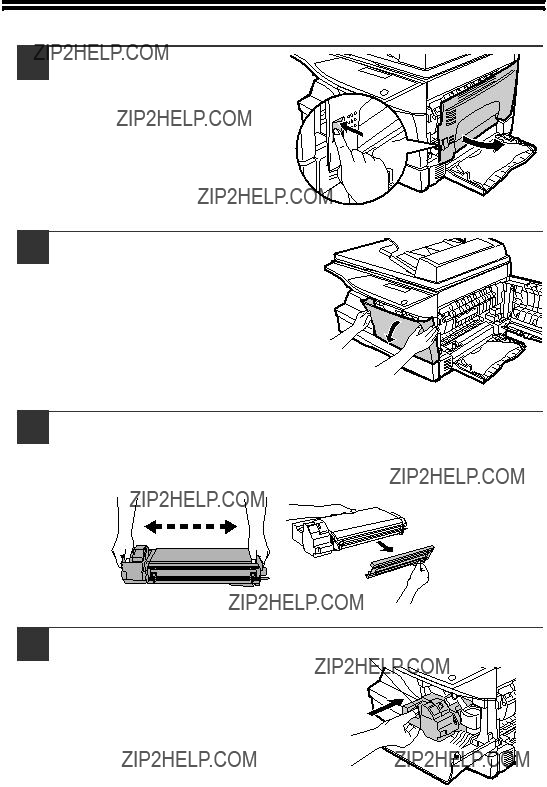
INSTALLING THE TD CARTRIDGE
1 Open the bypass tray, and then open the side cover.
2 Press gently on both sides of the front cover to open the cover.
3 Remove the TD cartridge from the bag. Remove the protective paper. Hold the cartridge on both sides and shake it horizontally four or five times. Hold the tab of the protective cover and pull the tab to your side to remove the cover.
4 or 5 times
14

PREPARATIONS
6
7
Ensure that the power switch of the unit is in the OFF position. Insert the attached power cord into the power cord socket at the rear of the unit.
Plug the other end of the power cord into the nearest outlet.
Only insert the power cord into a properly grounded wall socket.  Caution Do not use extension cords or power strips.
Caution Do not use extension cords or power strips.
15

POWER ON AND OFF
The power switch is located on the left side of the machine.
If you use the machine in a country other than the country  Caution where the machine was purchased, you will need to make sure
Caution where the machine was purchased, you will need to make sure
that your local power supply is compatible with your model. If you plug the machine into an incompatible power supply, irreparable damage to the machine will result.
Power on
Turn the power switch to the "ON" position.
The ready indicator will light up and other indicators which show the initial settings of the display will also light up to indicate the ready condition. For the initial settings, see the "Initial settings" (below).
You can select copy settings and press the [START] key ( ) during
) during
The first time the power is turned on after shipment from the factory, a message will appear in the display asking you to select the language. Select the language with the [ ] key (
] key (  ) or [
) or [ ] key (
] key (  ) and then press the [OK] key.
) and then press the [OK] key.
Initial settings
The machine reverts to the initial settings when it is first turned on, when the [CLEAR ALL] key (  ) is pressed, or when no keys are pressed for the preset "AUTO CLEAR" time following the end of a copy job. When the machine reverts to the initial settings, all settings and functions selected to that point are canceled. The "AUTO CLEAR" can be changed in the user programs. (p.64)
) is pressed, or when no keys are pressed for the preset "AUTO CLEAR" time following the end of a copy job. When the machine reverts to the initial settings, all settings and functions selected to that point are canceled. The "AUTO CLEAR" can be changed in the user programs. (p.64)
When in the copy mode
READY TO COPY.

 1,2,3, 1,2,3,
1,2,3, 1,2,3,
SP. FUNC
The main screen of copy mode appears.
Copy ratio: 100%, Exposure: Automatic
Copy quantity: 0, All special copier modes: Off
16
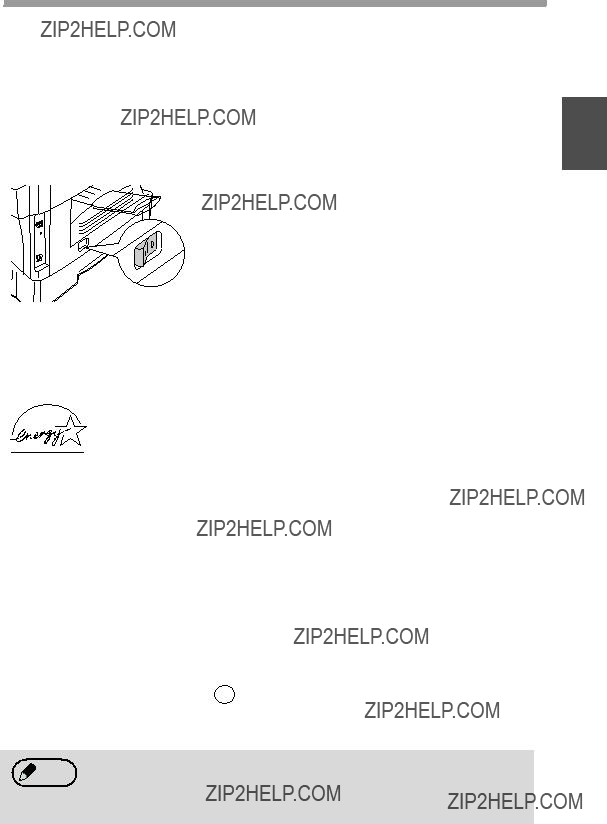
PREPARATIONS
About the scan head
The scan head lamp remains on constantly when the machine is in the ready condition (when the ready indicator is illuminated).
The machine adjusts the scan head lamp periodically to maintain copying quality. At this time, the scan head moves automatically. This is normal and does not indicate machine trouble.
switch to the "OFF" position.
If the power switch is turned off while the machine is in operation, a misfeed may occur and the job that was in progress will be canceled.
In cases where the machine will not be used for a long time, turn off the power switch and remove the power cord from the outlet.
Check the following to make sure the machine is not in operation:
???The ready indicator is lit. (Initial state)
???The power save indicator is lit. (preheat mode or auto
Power save modes
The machine has two power save modes to reduce overall power consumption and thereby reduce the cost of operation. In addition, these modes conserve natural resources and help reduce environmental pollution. The two power save modes are preheat mode and auto power
Preheat mode
This function automatically switches the machine to a low power consumption state if the set duration of time elapses without the machine being used when the power is on. In this mode, the power save indicator lights up. Normal operation automatically resumes when a key on the operation panel is pressed, an original is placed, a print job is received.
Auto power
This function automatically switches the machine to a state that consumes even less power than preheat mode if the set duration of time elapses without the machine being used when the power is on. The power save indicator lights up, the display shows a message indicating that the machine is in auto power  ). Normal operation also resumes automatically when a print job is received or scanning is begun from a computer. While in auto power
). Normal operation also resumes automatically when a print job is received or scanning is begun from a computer. While in auto power  )) can be used.
)) can be used.
The preheat activation time and the auto power
user programs. It is suggested that you set times that are appropriate for your usage of the machine. (p.64)
17

The tray location indicator will blink when there is no paper in the selected paper tray, or when the selected paper tray is not installed or is improperly installed.
PAPER
For best results, use only SHARP recommended paper.
*1 The number of sheets of paper that can be loaded varies depending on the weight of the paper.
*2 Do not use
*3 When loading paper larger than A4 size, do not use paper of weight greater than 105 g/m2.
18
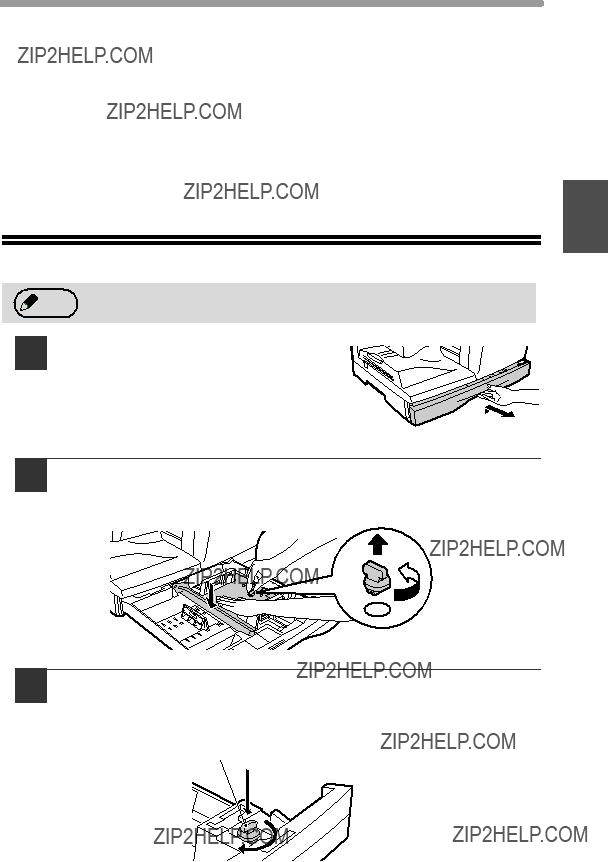
LOADING PAPER
Special papers
Follow these guidelines when using special papers.
??? Use SHARP recommended transparency film and label sheets. Using other than SHARP recommended paper may result in misfeeds or smudges on the output. If other than SHARP recommended media must be used, feed each sheet one at a time using the bypass tray (do not attempt continuous copying or printing).
??? There are many varieties of special paper available on the market, and some cannot be used with this machine. Before using special paper, contact a SHARP service center.
1
2
Raise the handle of the paper tray and pull the paper tray out until it stops.
Remove the pressure plate lock. Rotate the pressure plate lock in the direction of the arrow to remove it while pressing down on the pressure plate of the paper tray.
3 Store the pressure plate lock which has been removed in step 2. To store the pressure plate lock, rotate the lock to secure it as shown below.
Pressure plate lock
19
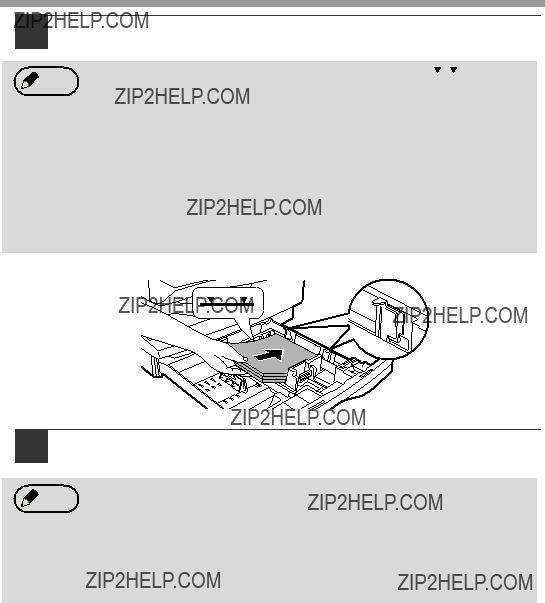
LOADING PAPER
4 Fan the paper and insert it into the tray. Make sure that the edges go under the corner hooks.
???If the paper is not fanned,
???Make sure the stack of paper is straight before loading it. When adding paper, take the remaining paper out and combine it into a single stack with the new paper.
???Make sure that all the paper in the stack is the same size and type.
???When loading paper, ensure that there is no space between the paper and the guide, and make sure that the guide is not set too narrow and causes the paper to bend. Incorrect loading will cause the paper to skew or misfeed.
5 Gently push the paper tray back into the machine.
??? If you loaded a different size of paper than was loaded previously in Note the tray, go to "CHANGING A TRAY'S PAPER SIZE SETTING"
(p.23)
???When not using the machine for an extended period, remove all paper from the paper tray and store it in a dry place. If paper is left in the machine for an extended period, the paper will absorb moisture from the air, resulting in paper jams.
20

BYPASS FEED (including special paper)
The bypass tray can be used to feed standard paper, transparency film, labels, envelopes, and other special purpose paper.
Important points when inserting paper in the bypass tray
Up to 50 sheets of standard copy paper can be inserted in the bypass tray. (Capacity will vary depending on the type of paper loaded.)
Be sure to place envelopes horizontally as shown in the following diagram.
2
Available Not
Available
???When loading envelopes, make sure that they are straight and flat and do not have loosely glued construction flaps (not the closure flap).
???Special papers except SHARP recommended transparency film, labels, and envelopes must be fed one sheet at a time through the bypass tray.
???When adding paper, first remove any paper remaining in the tray, combine it with the paper to be added and then reload as a single stack. The paper to be added must be the same size and type as the paper already in the tray.
???Do not use paper that is smaller than the original. This may cause smudges or unclean images.
???Do not use paper that has already been printed on by a laser printer or plain paper fax machine. This may cause smudges or unclean images.
Envelopes
Do not use the following envelopes, as misfeeds will occur.
???Envelopes with metal tabs, clasps, strings, holes, or windows.
???Envelopes with rough fibers, carbon paper, or glossy surfaces.
???Envelopes with two or more flaps.
???Envelopes with tape, film, or paper attached to the flap.
???Envelopes with a fold in the flap.
???Envelopes with glue on the flap to be moistened for sealing.
???Envelopes with labels or stamps.
???Envelopes that are slightly inflated with air.
???Envelopes with glue protruding from the seal area.
???Envelopes with part of the seal area peeled off.
???Be sure to select com9, com10 or Monarch in the paper size setting of the printer driver. (For detailed information on the printer driver, refer to the online manual.)
21

LOADING PAPER
Loading paper in the bypass tray
??? Paper must be fed narrow side first into the feed slot.
Note ??? Special papers such as transparency film, labels, and envelopes must be fed one sheet at a time through the bypass tray.
??? When copying onto transparency film, remove each copy promptly. Do not let copies stack up.
1 Open the bypass tray and extend the tray.
To close the bypass Note tray, perform step 1
and then step 2 in the illustration and push the round projections at the right of the tray until they click.
2 Set the bypass tray paper guides to the paper width. Insert the paper (print face down) all the way into the bypass tray.
Print face
3 Press the [TRAY SELECT] key ( ) to select the bypass tray.
) to select the bypass tray.
22
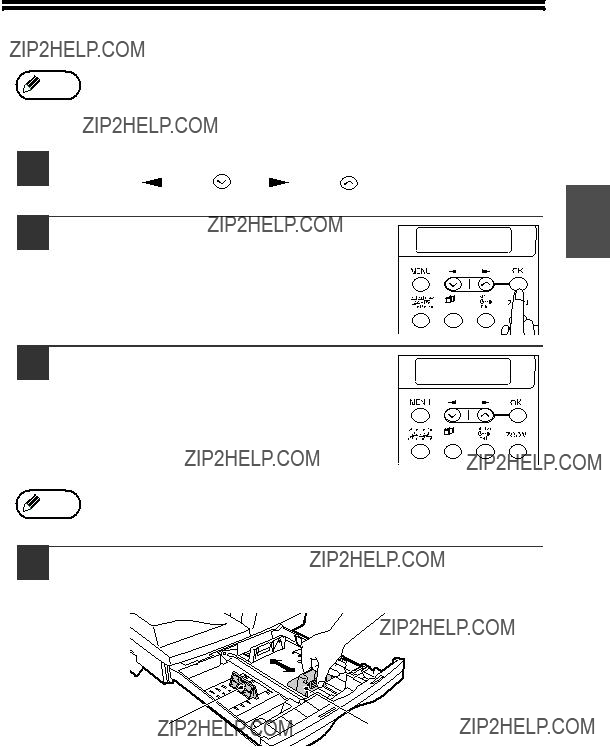
CHANGING A TRAY'S PAPER SIZE SETTING
Follow these steps to change a tray's paper size setting.
1:TRAY1
SP. FUNC
3 Press the [ ] key (
] key (  ) or [
) or [ ] key (
] key ( ) to select the paper size, and then press the [OK] key.
) to select the paper size, and then press the [OK] key.
The paper size changes as follows each time the [ ] key (
] key (  ) or [
) or [ ] key (
] key (  ) is pressed: "A4"???"B5"???"A5"???"8,5x14"???"8,5x13"???"8,5x11" ???"5,5x8,5".
) is pressed: "A4"???"B5"???"A5"???"8,5x14"???"8,5x13"???"8,5x11" ???"5,5x8,5".
TRAY1
1:A4
SP. FUNC
4 Squeeze the lock lever of the front guide and slide the front guide to match the width of the paper, and move the left guide to the appropriate slot as marked on the tray.
???The front guide is a
???The left guide is an
23
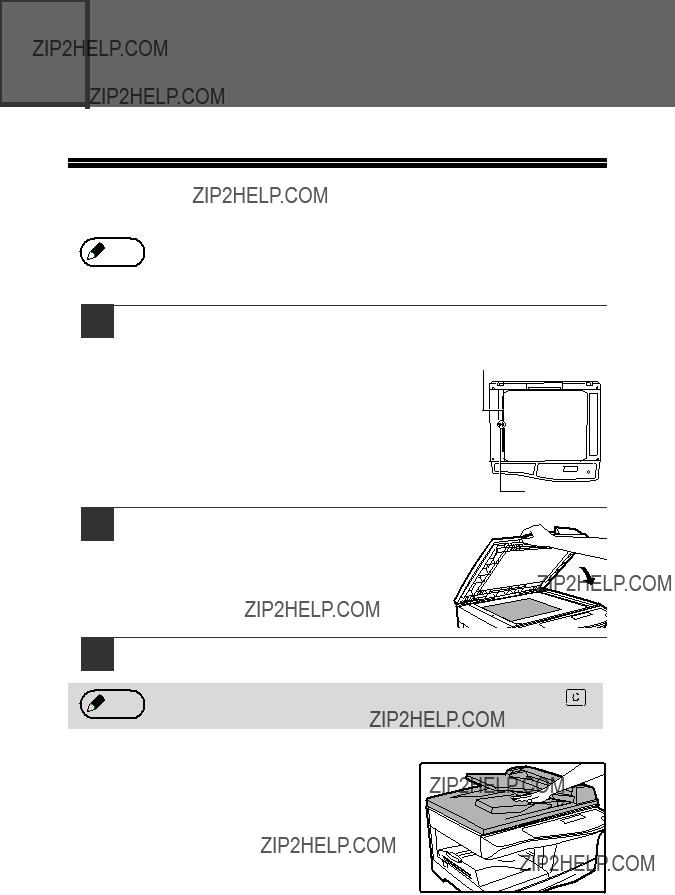
This chapter explains basic copying functions.
NORMAL COPYING
Using the document glass
1 Open the RSPF, and place the original face down on the
Align the original with the original scale and the centering ( ) mark.
) mark.
 mark
mark
2
3
Gently close the RSPF.
Select the number of copies and other copy settings, and then press the [START] key ( ).
).
Copying books or originals with folds or creases
Press down on the RSPF while copying as shown. If the RSPF is not completely closed, shadows may appear on the copy or it may be fuzzy. Straight originals with folds or creases well before placing.
24
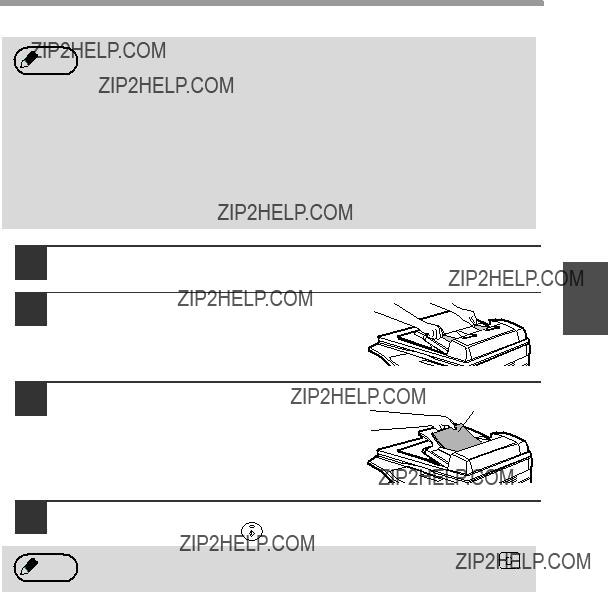
25
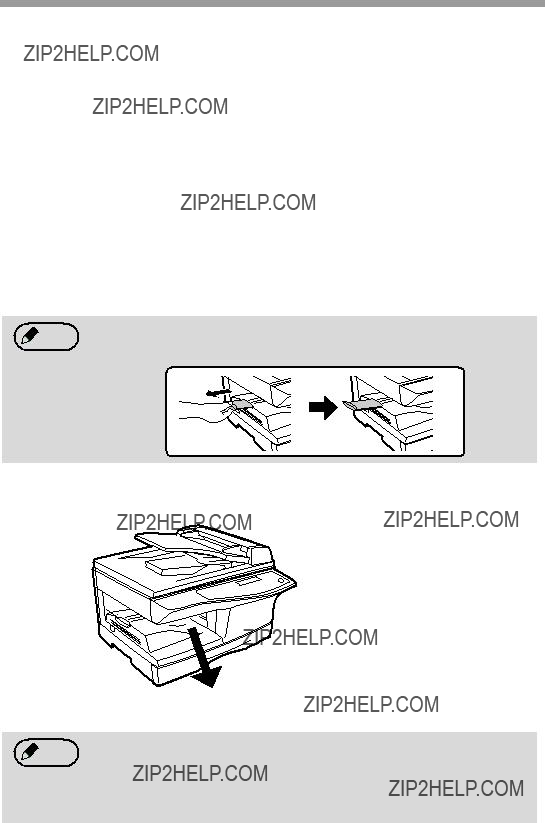
MAKING COPIES
Originals that cannot be used in the RSPF
The following originals cannot be used. These may cause misfeeds or smudging and unclear images.
???Transparencies, tracing paper, other transparent or translucent paper, and photographs.
???Carbon paper, thermal paper.
???Originals that are creased, folded, or torn.
???Glued originals,
???Originals with binder holes.
???Originals printed using an ink ribbon (thermal transfer printing), originals on thermal transfer paper.
Stream feeding mode
"SET ORIGINALS FOR STREAM FEEDING" will appear in the display for five seconds after all originals are fed. If a new original is placed in the RSPF during this time, the original will be automatically fed in and copying will begin with the same setting. The stream feeding mode is disabled in "STREAM FEEDING" in the user programs (p.65).
Note
When copying onto paper larger than A4 size, pull out the paper output tray extension.
Capacity of paper output tray
Maximum number of pages that can be held in the tray: 250
???After removing paper, if you need to return the paper to the paper output tray, lift up the paper holder arm and place the paper under the arm.
26
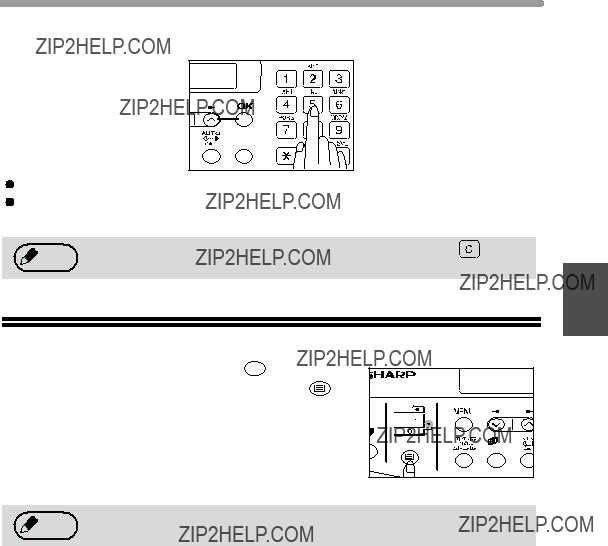
MAKING COPIES
Setting the number of copies
Press the numeric keys to set the number of copies.
COPY.
55
ZOOM
The set number of copies appears in the display. A maximum of 99 copies can be set. If you wish to make only a single copy, copying is possible with the display showing "0".
SELECTING THE TRAY
Press the [TRAY SELECT] key ( 

 ).
).
3
READY TO COPY.
27

MAKING A COPY DARKER OR LIGHTER
Automatic exposure adjustment is initially enabled. This function automatically adjusts the copy image according to the original being copied. If you wish to select the exposure level yourself, follow the steps below. (Select from two original types and five exposure levels for each original type.) The exposure level used in automatic exposure adjustment can also be changed with "AE LEVEL ADJUST" in the user programs (p.67).
Original types
???AUTO ...... Automatic exposure adjustment is enabled and the exposure is automatically adjusted according to the original being copied. The exposure is lowered for colored areas and background shadows.
???TEXT....... The exposure is raised for light areas and lowered for dark backgrounds to make text easier to read.
???PHOTO ... Halftones in the photo are reproduced with greater clarity.
3 If needed, adjust the exposure level for TEXT (

 ) or PHOTO (
) or PHOTO (  ).
).
For a darker image, press the [ ] key (
] key (  ). For a lighter image, press the [
). For a lighter image, press the [ ] key (
] key (  ).
).
TEXT
 | | | | |
| | | | | 
 1,2,3, 1,2,3,
1,2,3, 1,2,3,
SP. FUNC
4
5
Press the [OK] key.
Select the number of copies and any other copy settings, and then press the [START] key (  ).
).
Note
Exposure value guidelines (When in "TEXT"(

 ) setting)
) setting)
 | | | | |
| | | | | 
Colored text or text written in pencil
Normal originals
Dark originals like newspapers
28

REDUCTION/ENLARGEMENT/ZOOM
Copies can be reduced down to 25% or enlarged up to 400%. (When the RSPF is being used, the zoom copy ratio range is 50% to 200%.) The [ZOOM] key can be pressed to quickly select a ratio from among eight preset ratios. In addition, the [ ] key (
] key (  ) and [
) and [ ] key (
] key (  ) can be pressed to select the ratio in increments of 1%.
) can be pressed to select the ratio in increments of 1%.
1
2
Check the original and paper size, and place the original(s).
Press the [ZOOM] key.
COPY RATIO
- 100% +
 1,2,3,
1,2,3,  1,2,3,
1,2,3,
SP. FUNC
Selecting a preset ratio
The preset ratios change as follows each time the [ZOOM] key is pressed:
"100%" ??? "86%" ??? "70%" ??? "50%" ??? "25%" ??? "400%" ??? "200%" ??? "141%".
A4 TO B5
- 86% +
SP. FUNC
Fine adjustment of the ratio
The ratio can be adjusted from 25% to 400% in increments of 1%.
Use the [ ] key (
] key (  ) or the [
) or the [ ] key (
] key ( ) for fine adjustment.
) for fine adjustment.
ZOOM
-99% +
 1,2,3, 1,2,3,
1,2,3, 1,2,3,
SP. FUNC
??? To return the ratio to 100%, press the [ZOOM] key until 100% Note appears.
???Press the [ZOOM] key to set the approximate ratio, then press the [ ] key (
] key (  ) or [
) or [ ] key (
] key (  ).
).
???To decrease or increase the zoom ratio rapidly, hold down the [ ] key (
] key (  ) or [
) or [ ] key (
] key (  ).
).
The ratio will stop changing at each of the preset ratios. To continue changing the ratio, release the key and then hold it down again.
4 Select the number of copies and any other copy settings, and then press the [START] key ( ).
).
The copy will be delivered to the paper output tray.
29
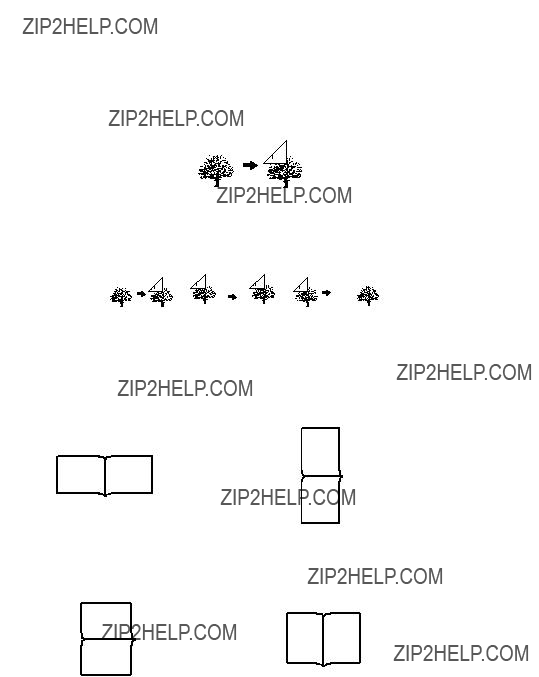
AUTOMATIC
Two originals can be automatically copied onto both sides of a single sheet of paper. When the RSPF is used,
When performing automatic
SHORT EDGE: Select when binding the paper at the short edge.
A
A B
B
(Paper orientation: Landscape) (Paper orientation: Portrait)
LONG EDGE: Select when binding the paper at the long edge.
A
A B
B
(Paper orientation: Landscape) (Paper orientation: Portrait)
30

CONVENIENT COPY FUNCTIONS
Using the document glass
1
2
Place the original that you wish to copy onto the front side of the paper on the document glass and close the RSPF.
Press the 

 )] key
)] key
until "1 TO 2" appears, and then press the  1 TO 2
1 TO 2
[OK] key.
 1,2,3,
1,2,3,  1,2,3,
1,2,3,
SP. FUNC
3 Press the [ ] key (
] key (  ) or [
) or [ ] key (
] key ( ) to select the binding edge and then press the [OK] key.
) to select the binding edge and then press the [OK] key.
Select "LONG EDGE" or "SHORT EDGE". The "LONG EDGE" and "SHORT EDGE" are shown in the illustration on the preceding page.
BINDING EDGE
 LONG EDGE
LONG EDGE
 1,2,3,
1,2,3,  1,2,3,
1,2,3,
SP. FUNC
The original for the front side is scanned into the memory.
???If you wish to cancel  ] key.
] key.
5 When "[START] : NEXT SCAN [#] : START PRINT" appears, remove the first original and then place the original that you wish to copy onto the back side of the paper on the document glass. Close the RSPF.
Place the second original in the same orientation as the first original.
The first original The second original
6 Press the [START] key ( ).
).
The copy will be delivered to the paper output tray.
To cancel automatic  ) or press the
) or press the 

 )] key, select the "1 TO 1",
)] key, select the "1 TO 1",
and then press the [OK] key.
31
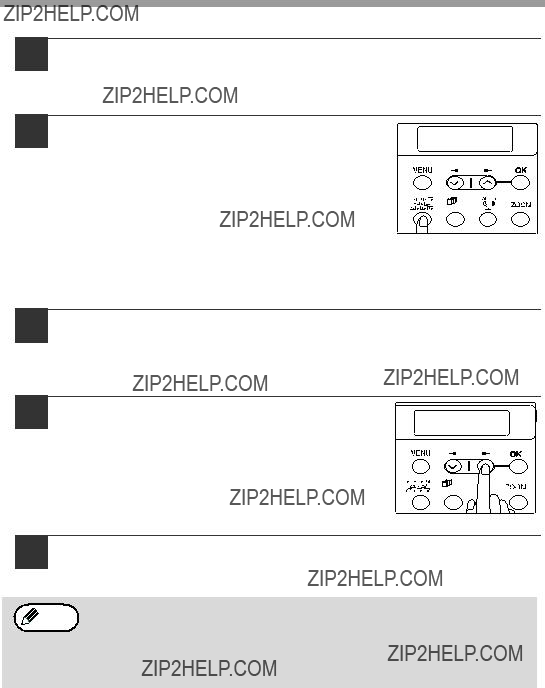
CONVENIENT COPY FUNCTIONS
Using the RSPF
1
Place the original(s) in the RSPF. (p.25)
If you place an odd number of originals for
2
Press the 

 )] key and select the
)] key and select the
The mode changes as follows each time you press the 

 )] key: "1 TO 1", "1 TO 2", "2 TO 2", "2 TO 1"
)] key: "1 TO 1", "1 TO 2", "2 TO 2", "2 TO 1"
2 TO 1
SP. FUNC
???
???
???
3 Press the [OK] key.
If you selected "1 TO 2" in step 2, select "LONG EDGE" or "SHORT EDGE" and press the [OK] key. LONG EDGE and SHORT EDGE are shown in the illustration on page 30.
4 If you selected "2 TO 2" or "2 TO 1", press the [ ] key (
] key (  ) or [
) or [ ] key (
] key ( ) to select the original size and then press the [OK] key.
) to select the original size and then press the [OK] key.
The following original sizes can be selected: "A4", "B5", "A5", "8.5x14", "8.5x13", "8.5x11", "8.5x5.5"
ORIG. SIZE ENTER  A4
A4
SP. FUNC
5 Select the number of copies and any other copy settings, and press the [START] key ( ).
).
The copy will be delivered to the paper output tray.
??? To cancel automatic  ) or press the
) or press the 

 )] key, select the "1 TO
)] key, select the "1 TO
1", and then press the [OK] key.
???Do not touch the reversing tray while automatic
32
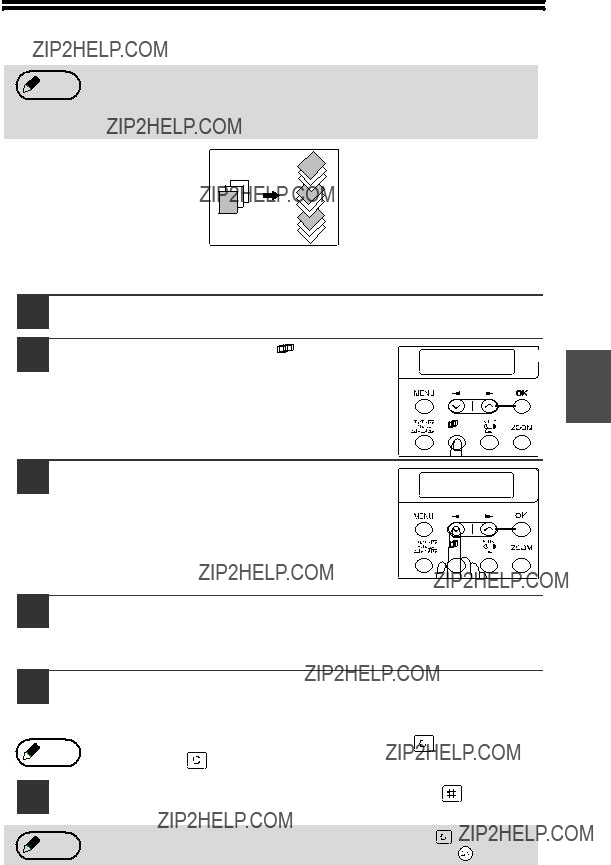
SORT COPY
Copies of multiple original pages can sorted into sets.
The number of pages that can be scanned varies depending on the Note original type (photo, text, etc.) and the amount of memory allocated to
the printer. The amount of memory allocated to the printer can be changed with "MEM. FOR PRINTER" in the user programs. (p.66)
3
2
1
Sort copy
1 2 3
1 2 3
1 2 3
Using the document glass
1
2
Place the first original. (p.24)
3 Press the [ ] key (
] key (  ) to move "
) to move " " to the "ON" position and then press the [OK] key.
" to the "ON" position and then press the [OK] key.
SORT
 ON OFF
ON OFF
 1,2,3, 1,2,3,
1,2,3, 1,2,3,
SP. FUNC
4
5
Select the number of copies and any other settings, and then press the [START] key ( ).
).
"[START] : NEXT SCAN [#] : START PRINT" appears and the original is scanned into memory.
Replace the original with the next original, and then press the [START] key ( ).
).
Repeat step 5 until all originals have been scanned into memory.
The copies are delivered to the paper output tray.
33
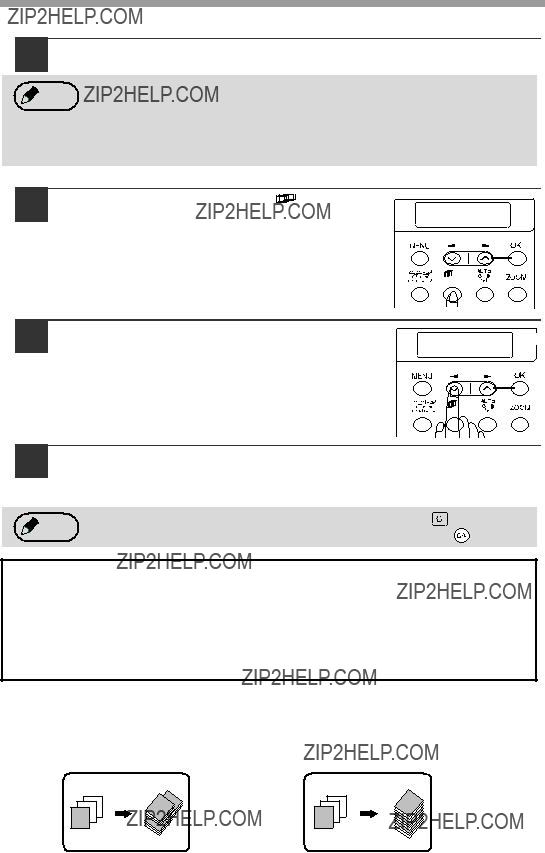
CONVENIENT COPY FUNCTIONS
Using the RSPF
1 Place the originals. (p.25)
??? If "SORT AUTO SELCT" is enabled in the user programs, the default output Note mode for copying from the RSPF is sort mode (p.65). In this case go directly to step 4. A checkmark " " will automatically appear in the display (p.11).
" will automatically appear in the display (p.11).
???If "SORT AUTO SELECT" is disabled, the default output mode will be
1,2,3,
until "SORT" appears and then press the [OK] key.
SPECIAL FUNCTION
SORT
 1,2,3,
1,2,3,  1,2,3,
1,2,3,
SP. FUNC
3 Press the [ ] key (
] key (  ) to move "
) to move " " to the "ON" position and then the [OK] key.
" to the "ON" position and then the [OK] key.
SORT
 ON OFF
ON OFF
 1,2,3, 1,2,3,
1,2,3, 1,2,3,
SP. FUNC
4 Select the number of copies and any other settings, and then press the [START] key ( ).
).
The copies are delivered to the paper output tray.
If the memory becomes full
???If the memory becomes full while scanning the originals, "MEMORY FULL, PRESS START TO RESUME" will appear in the display, and the machine will stop copying.
???To copy the originals that have been scanned up to that point, press the [START] key ( ).
).
???To clear the data that has been scanned into memory, press the [CLEAR ALL] key ( ) or the [CLEAR] key (
) or the [CLEAR] key ( ).
).
Offset function during sort copy
The offset function shifts the position of each set of copies in the paper output tray for easy separation.
The offset function can be changed with "OFFSET FUNCTION" in the user programs. (p.65)
3
2
1
3
2
1
1
34

COPYING MULTIPLE ORIGINALS ONTO A SINGLE SHEET OF PAPER(2 IN 1 copy)
Multiple originals can be copied onto a single sheet of paper in a selected layout pattern.
This function is convenient for compiling
Using the document glass
1
2
Place the first original. (p.24)
Press the 


 1,2,3, )] key
1,2,3, )] key
1,2,3,
SP. FUNC
SPECIAL FUNCTION
until "2IN1" appears and then press the 2IN1
[OK] key.
 1,2,3, 1,2,3,
1,2,3, 1,2,3,
SP. FUNC
3 Press the [ ] key (
] key (  ) to move "
) to move " " to the "ON" position and then press the [OK] key.
" to the "ON" position and then press the [OK] key.
2IN1
 ON OFF
ON OFF
 1,2,3, 1,2,3,
1,2,3, 1,2,3,
SP. FUNC
35
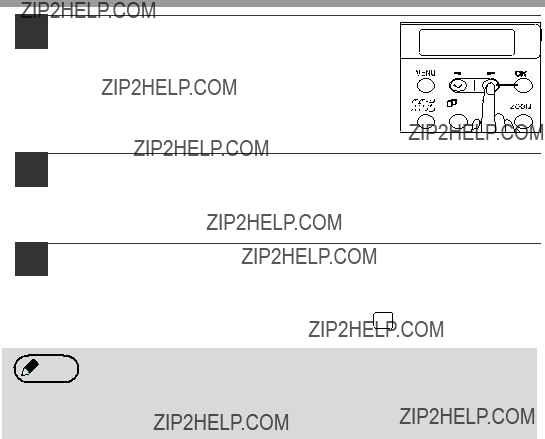
CONVENIENT COPY FUNCTIONS
4 Press the [ ] key (
] key (  ) or [
) or [ ] key (
] key ( ) to select the original size and then press the [OK] key.
) to select the original size and then press the [OK] key.
The following original sizes can be selected: "A4", "B5", "A5", "8.5x14", "8.5x13", "8.5x11", "8.5x5.5"
ORIG. SIZE ENTER  A4
A4
SP. FUNC
5
6
Set the number of copies and any other settings, and then press the [START] key ( ).
).
"[START] : NEXT SCAN [#] : START PRINT" appears and the original is scanned into memory.
To immediately print the scanned image, press the [ ] key.
] key.
Replace the original with the next original, and then press the [START] key ( ).
).
Repeat step 6 until all originals have been scanned.
Copies will be output each time two originals have been scanned.
If the number of original pages is odd, press the [  ] key after all pages have been scanned.
] key after all pages have been scanned.
??? To clear the data in memory, press the [CLEAR] key ( ). Note When the [CLEAR] key (
). Note When the [CLEAR] key ( ) is pressed, the number of copies
) is pressed, the number of copies
setting is also cleared.
???To cancel 2 IN 1 copying, press the [CLEAR] key ( ).
).
???To cancel 2 IN 1 copy mode, press the [CLEAR ALL] key ( ).
).
36
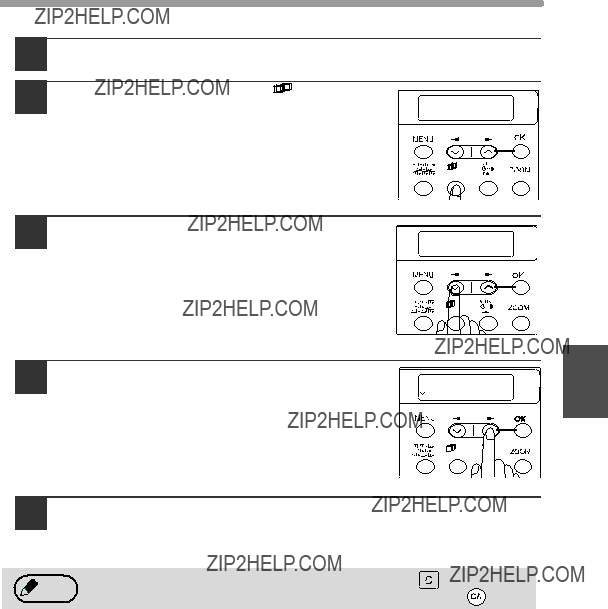
CONVENIENT COPY FUNCTIONS
Using the RSPF
3 Press the [ ] key (
] key (  ) to move "
) to move " " to the "ON" position and then press the [OK] key.
" to the "ON" position and then press the [OK] key.
2IN1
 ON OFF
ON OFF
 1,2,3, 1,2,3,
1,2,3, 1,2,3,
SP. FUNC
4 Press the [ ] key (
] key (  ) or [
) or [ ] key (
] key ( ) to select the original size and then press the [OK] key.
) to select the original size and then press the [OK] key.
The following original sizes can be selected: "A4", "B5", "A5", "8.5x14", "8.5x13", "8.5x11", "8.5x5.5"
SP. FUNC
5 Select the number of copies and other settings, and press the [START] key ( ).
).
The copy is delivered to the paper output tray.
37
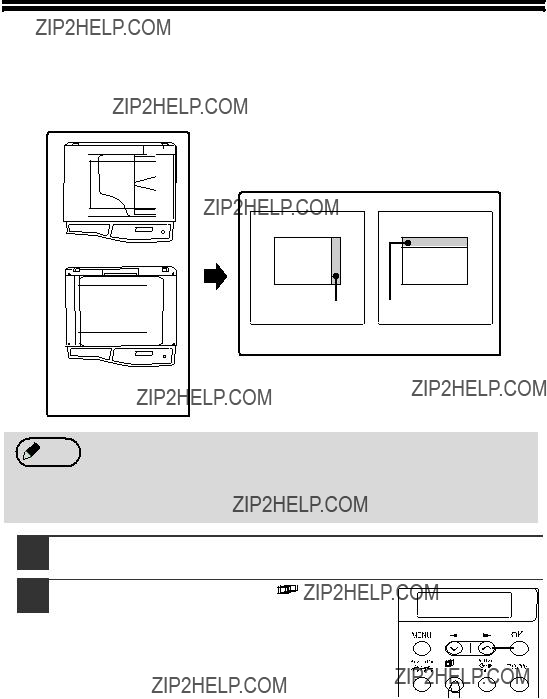
CREATING MARGINS WHEN COPYING
(Margin shift)
The margin shift function is used to automatically shift the text or image or the copy paper approximately 10mm.
As shown below, LONG EDGE or SHORT EDGE can be selected.
AB
RSPF  AB
AB
SHORT EDGE LONG EDGE
Document glass
Original
???Note that a margin is created by shifting the image, and thus if the image is shifted too far, the edge of the image may be cut off.
1
2
Place the original(s).
press the [OK] key.
 1,2,3, 1,2,3,
1,2,3, 1,2,3,
SP. FUNC
38

CONVENIENT COPY FUNCTIONS
3 Press the [ ] key (
] key (  ) to move "
) to move " " to the "ON" position and then press the [OK] key.
" to the "ON" position and then press the [OK] key.
MARGIN SHIFT
 ON OFF
ON OFF
 1,2,3, 1,2,3,
1,2,3, 1,2,3,
SP. FUNC
4 Press the [ ] key (
] key (  ) or [
) or [ ] key (
] key ( ) to select the margin position and then press the [OK] key.
) to select the margin position and then press the [OK] key.
Select "LONG EDGE" or "SHORT EDGE".
For the margin position, see the previous page.
MARGIN SHIFT
 LONG EDGE
LONG EDGE
 1,2,3, 1,2,3,
1,2,3, 1,2,3,
SP. FUNC
5 Select the number of copies and other settings, and then press the [START] key (  ).
).
The copy is delivered to the paper output tray.
39

This chapter explains how to install and configure the software that is required for the printer and scanner functions of the machine. The procedure for viewing the Online Manual is also explained.
??? The screen images in this manual are mainly for Windows XP. With Note other versions of Windows, some screen images may be different
from those in this manual.
???Where
???This manual refers to the
SOFTWARE FOR
The
MFP driver
Printer driver
The printer driver enables you to use the printer function of the machine.
The printer driver includes the Print Status Window. This is a utility that monitors the machine and informs you of the printing status, the name of the document currently being printed, and error messages.
Please note that the Print Status Window does not operate when the machine is used as a network printer.
Scanner driver (USB only)
The scanner driver allows you to use the scanning function of the machine with
Sharpdesk (USB only)
Sharpdesk is an integrated software environment that makes it easy to manage documents and image files, and launch applications.
Button Manager (USB only)
Button Manager allows you to use the scanner menus on the machine to scan a document.
The scanning feature can only be used with computers that are running Note Windows 98/Me/2000/XP and are connected to the machine by a USB
cable. If you are running Windows 95/NT 4.0 or are connected to the machine by a LAN connection, only the printer function can be used.
40
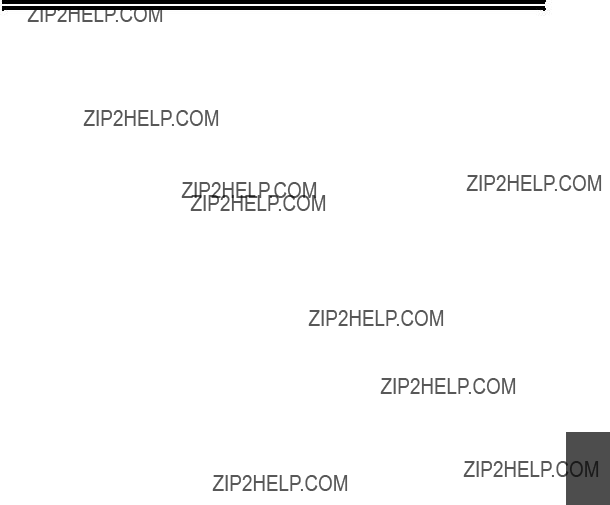
BEFORE INSTALLATION
Hardware and software requirements
Check the following hardware and software requirements in order to install the software.
*1 The machine's USB connector will transfer data at the speed specified by the USB 2.0
Installation environment and usable software
The following table shows the drivers and software that can be installed for each version of Windows and interface connection method.
*1Windows 98/Me does not support USB 2.0. A USB 2.0 connection can be used in Windows 98/Me, however, the performance will be the same as USB 1.1. The print speed based on USB 2.0 specifications can only be attained if your computer is running Windows 2000/XP, you are using a cable that supports USB 2.0 (USB 1.1 or USB 2.0 certified), and the cable is connected to a USB 2.0 port on your computer. If the connection is made through a hub, the hub must support USB 2.0.
*2 The printer driver that is installed will vary depending on the type of connection between the machine and your computer.
41

INSTALLING THE SOFTWARE
??? If you need to use a different connection method after installing the Note software using a USB or network connection, you must first uninstall
the software (p.79) and then install it using the new connection method.
???In the following explanations it is assumed that the mouse is configured for right hand operation.
???The scanner feature only works when using a USB cable.
???If an error message appears, follow the instructions on the screen to solve the problem. After the problem is solved, the installation procedure will continue. Depending on the problem, you may have to click the "Cancel" button to exit the installer. In this case, reinstall the software from the beginning after solving the problem.
???When installing Sharpdesk, a minimal version of Internet Explorer 5.01 will be installed on your computer if your computer does not currently have Internet Explorer version 4.01 or later.
Using the machine with a USB connection
1 The USB cable must not be connected to the machine. Make sure that the cable is not connected before proceeding.
If the cable is connected, a Plug and Play window will appear. If this happens, click the "Cancel" button to close the window and disconnect the cable.
2
3
Insert the
Click the "start" button, click "My Computer" (  ), and then
), and then  ).
).
In Windows 98/Me/2000,
4  ).
).
If the language selection screen appears after you double click the Note "setup" icon, select the language that you wish to use and click the
"Next" button. (Normally the correct language is selected automatically.)
5
6
The "SOFTWARE LICENCE" window will appear. Make sure that you understand the contents of the software licence, and then click the "Yes" button.
Read the "Readme First" in the "Welcome" window and then click the "Next" button.
42
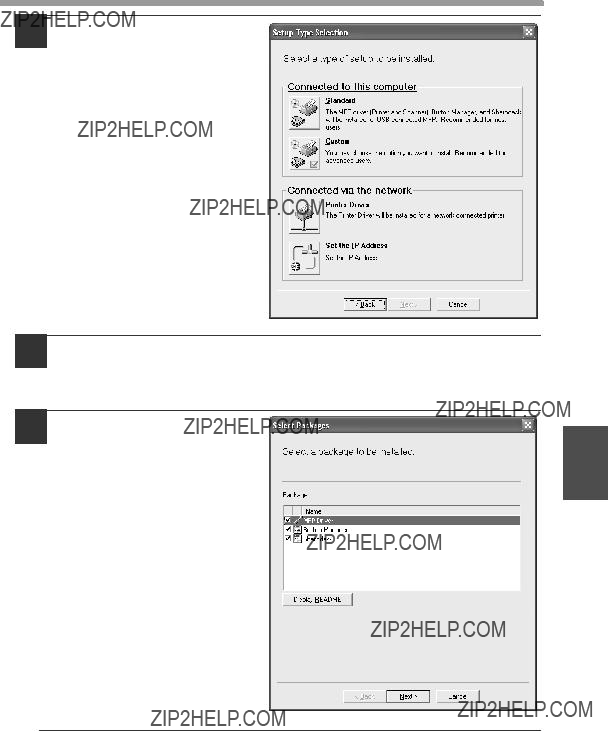
SET UP THE SOFTWARE
7 To install all of the software, click the "Standard" button. To install particular packages, click the "Custom" button.
If you selected "Custom", go to step 9.
8 Read the message in the "Welcome" window and then click the "Next" button.
If you selected "Standard" in step 7, installation will begin.
Go to step 14.
9
10
If you clicked the "Custom" button, select
the checkboxes of the5 software packages to be
installed and then click the "Next" button.
Click the "Display README" button to show information on packages that are selected.
Check the packages on the screen, and then click the "Start" button.
The software packages to be installed will be displayed on the screen. If an incorrect package is displayed, click the "Back" button and select the correct packages.
43

SET UP THE SOFTWARE
11 The files required for installation of the MFP driver are copied (if "MFP Driver" was selected).
Follow the
If you are running Windows 2000/XP and a warning message appears  Caution regarding the Windows logo test or digital signature, be sure to click
Caution regarding the Windows logo test or digital signature, be sure to click
"Continue Anyway" or "Yes".
When "The installation of the SHARP software is complete" appears, click the "OK" button.
12 Begin the installation of Button Manager (if "Button Manager" was selected).
Follow the
Click the "Finish" button when the message informs you that setup is successful.
The Sharpdesk installer will start.
13 Begin the installation of Sharpdesk (if "Sharpdesk" was selected).
Follow the
Click the "Finish" button when the message informs you that Setup is complete.
In Windows 98/Me/2000, if the following screen appears, click the  Caution "Skip" button or the "Continue" button as appropriate to continue the
Caution "Skip" button or the "Continue" button as appropriate to continue the
Sharpdesk installation.
If "Skip" is selected, the Sharpdesk installation will continue without installing Sharpdesk Imaging.
If "Continue" is selected, Sharpdesk Imaging will be installed. If Imaging for Windows is installed on your computer, Sharpdesk
Imaging will overwrite Imaging for Windows.
44

SET UP THE SOFTWARE
14 When the "Finish" screen appears, click the "Close" button.
If you are running Windows 2000/XP and a warning message appears  Caution regarding the Windows logo test or digital signature, be sure to click
Caution regarding the Windows logo test or digital signature, be sure to click
"Continue Anyway" or "Yes".
A message will appear instructing you to connect the machine to your computer. Click the OK button.
???After the installation, a message prompting you to restart your computer may appear. In this case, click the "Yes" button to restart your computer.
15 Make sure that the power of the machine is turned on, and then connect the USB cable (p. 46).
Windows will detect the machine and a Plug and Play screen will appear.
If the following message appears on your computer screen, close it.
 Caution
Caution
A window regarding
the window.5 This message appears when the machine's USB 2.0 mode is not set to
Chapter 6, "PRINTER/SCANNER FUNCTIONS".
16 Begin installation of the scanner driver.
"SHARP
If you are running Windows 2000/XP and a warning message appears  Caution regarding the Windows logo test or digital signature, be sure to click
Caution regarding the Windows logo test or digital signature, be sure to click
"Continue Anyway" or "Yes".
A "USB 2.0 Composite Device" installation window may appear prior to Note this procedure. In this case, follow the instructions in the window to
install the USB 2.0 Composite Device.
45

SET UP THE SOFTWARE
17 Begin installation of the printer driver.
"SHARP
If you are running Windows 2000/XP and a warning message appears  Caution regarding the Windows logo test or digital signature, be sure to click
Caution regarding the Windows logo test or digital signature, be sure to click
"Continue Anyway" or "Yes".
18 Follow the instructions in the Plug and Play screen that appears in your version of Windows to begin the installation.
This completes the installation of the software.
???If you installed Button Manager, set up Button Manager as explained in "SETTING UP BUTTON MANAGER" (p. 55).
Connecting a USB cable
Follow the procedure below to connect the machine to your computer.
A USB cable for connecting the machine to your computer is not included with the machine. Please purchase the appropriate cable for your computer.
???The machine's USB connector will transfer data at the speed specified by the USB 2.0
???To obtain the fastest USB 2.0 data transfer speed, "USB2.0 MODE SWITCH" in the machine's user programs must be set to
???Use the machine's
???Even when the Microsoft USB 2.0 driver is used, it may not be possible to obtain full USB 2.0 speed if a PC card supporting USB 2.0 is used. To obtain the latest driver (which may enable a higher speed), contact the manufacturer of your PC card.
???Connection is also possible using a USB 1.1 port on your computer. However, the specifications will be USB 1.1 specifications
46

SET UP THE SOFTWARE
1 Insert the cable into the USB connector on the machine.
2 Insert the other end of the cable into your computer's USB port.
Using the machine as a network printer
??? Interface cables for connecting the machine to your computer are not Note included with the machine. Please purchase the appropriate cable for
your computer.
???If you intend to use the machine as a scanner, it must be connected to your computer with a USB interface cable. The scanner function cannot be used if the machine is connected with a LAN cable.
???To install the software using a network connection in Windows 95, Internet Explorer version 4.01 or later must be installed on your computer. If this is not installed,
1
2
3
4
Use a network cable that is shielded.
Turn on the machine.
Insert the
Click the "start" button, click "My Computer" (  ), and then
), and then  ).
).
In Windows 95/98/Me/NT 4.0/2000,
47
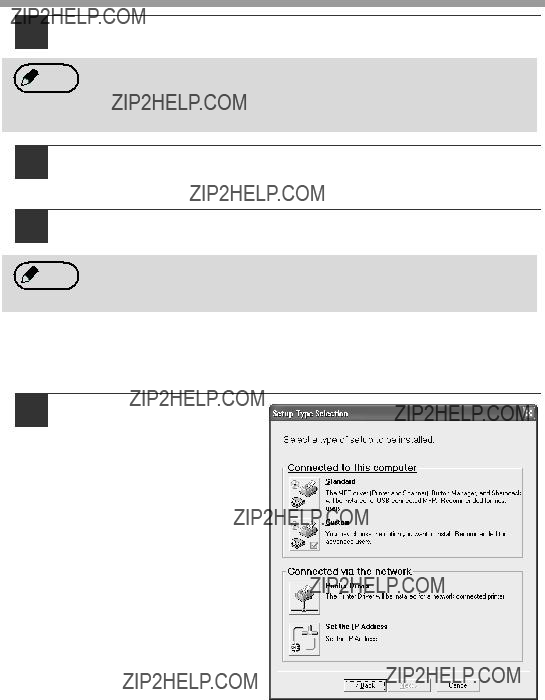
SET UP THE SOFTWARE
5  ).
).
If the language selection screen appears after you double click the Note "setup" icon, select the language that you wish to use and click the
"Next" button. (Normally the correct language is selected automatically.)
6
7
The "SOFTWARE LICENCE" window will appear. Make sure that you understand the contents of the software licence, and then click the "Yes" button.
Read the "Readme First" in the "Welcome" window and then click the "Next" button.
To set the IP address of the machine, follow the steps below. If the Note machine is already connected to the network and its IP address has
been set, go to "LPR (TCP/IP) direct printing" (p.50).
Set the IP Address
This setting is only required once when using the machine on a network.
8 Click the "Set the IP
Address" button.
48
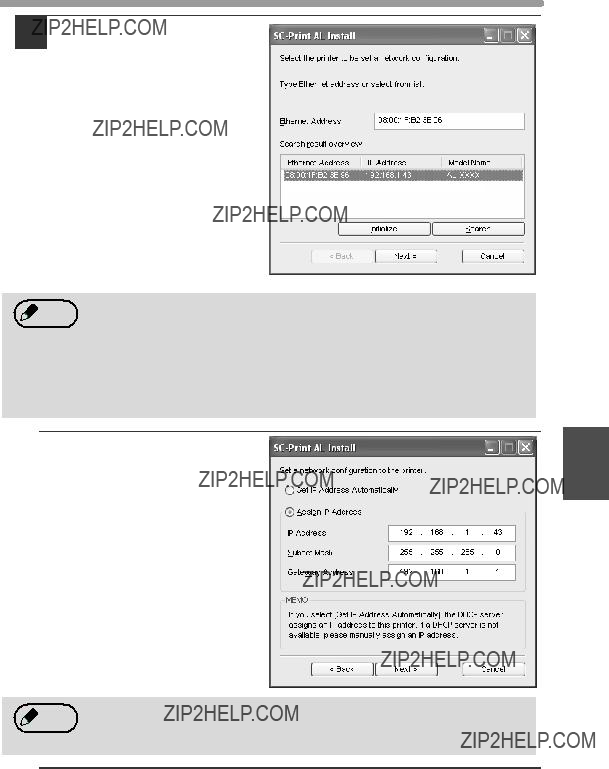
SET UP THE SOFTWARE
9 The printer or printers connected to the network will be detected. Click the printer to be configured (the machine) and click the "Next" button.
???If the machine is used on a different network after the IP address is set, the machine will not be recognized. Enter the Ethernet Address and click the "Initialize" button to initialize the IP address. Follow the
The settings in the above window are examples.
Be sure to ask your network administrator for the correct IP address, subnet mask, and default gateway to be entered.
When "Get IP Address Automatically" is selected, the IP address may Note at times change automatically. This will prevent printing. In this event,
select "Assign IP Address" and enter the IP address.
11 Click the "Next" button.
49

SET UP THE SOFTWARE
12 Click the "Yes" button.
Go to step 11 on page 51.
LPR (TCP/IP) direct printing
After step
8 Click the "Printer Driver"
button.
If you have not set the IP Address, click the "Set the IP Address" button in first and go to step 8 on page 48.
9
10
Read the message in the "Welcome" window and then click the "Next" button.
Select "LPR (TCP/IP) direct printing" and click the "Next" button.
50

SET UP THE SOFTWARE
11 The printer or printers connected to the network will be detected. Click the printer to be configured (the machine) and click the "Next" button.
If the machine's IP address cannot be found, make sure the machine is Note powered on, make sure the network cable is connected correctly, and
then click the "Search" button.
Make sure that the entries are correct and then click the "Finish" button.
If any of the entries are incorrect, click the "Back" button to return to the appropriate window and correct the entry.
51
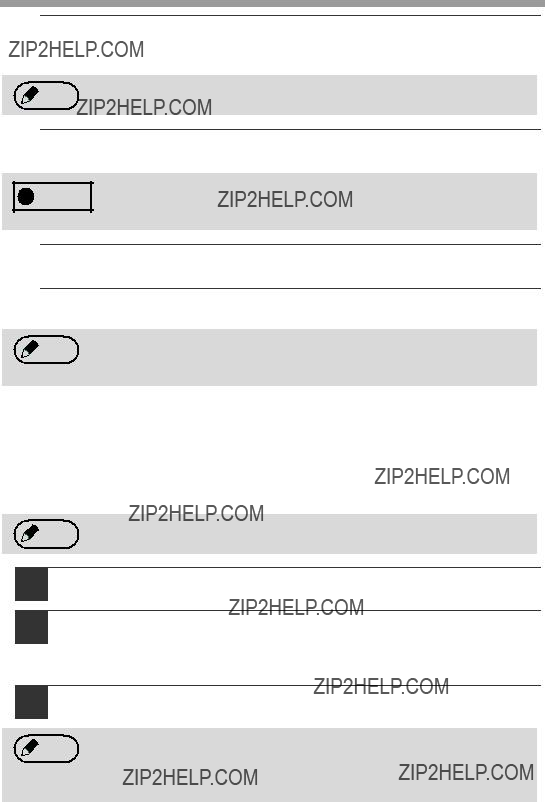
SET UP THE SOFTWARE
14 When the model selection window appears, select the model name of your machine and click the "Next" button.
For the model name of your machine, see the operation panel on the machine.
15 Select whether or not you wish the printer to be your default printer and click the "Next" button.
If you are running Windows 2000/XP and a warning message appears  Caution regarding the Windows logo test or digital signature, be sure to click
Caution regarding the Windows logo test or digital signature, be sure to click
"Continue Anyway" or "Yes".
16
17
When "This installation of the SHARP software is complete" appears, click the "OK" button.
When the "Finish" screen appears, click the "Close" button.
After the installation, a message prompting you to restart your computer Note may appear. In this case, click the "Yes" button to restart your
computer.
This completes the installation of the software.
Sharing the printer using windows networking
If the machine will be used as a shared printer on a network, follow these steps to install the printer driver in the client computer.
1
2
Insert the
Click the "start" button, click "My Computer" (  ), and then
), and then  ).
).
In Windows 95/98/Me/NT 4.0/2000,
3  ).
).
If the language selection screen appears after you double click the Note "setup" icon, select the language that you wish to use and click the
"Next" button. (Normally the correct language is selected automatically.)
52
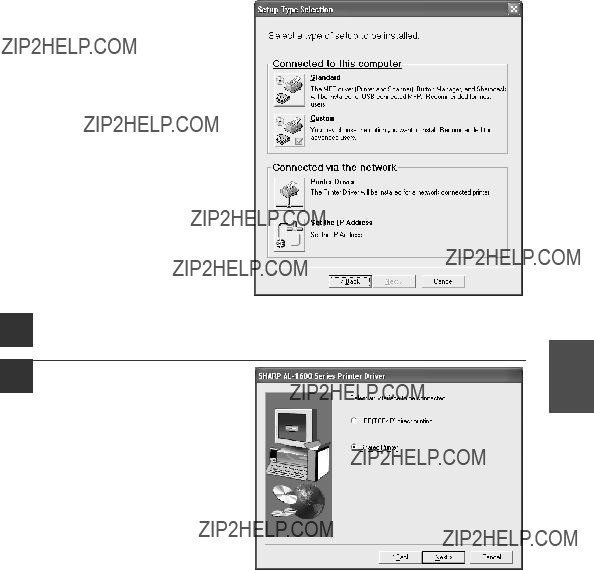
6
7
Read the message in the "Welcome" window and then click the "Next" button.
button.
53
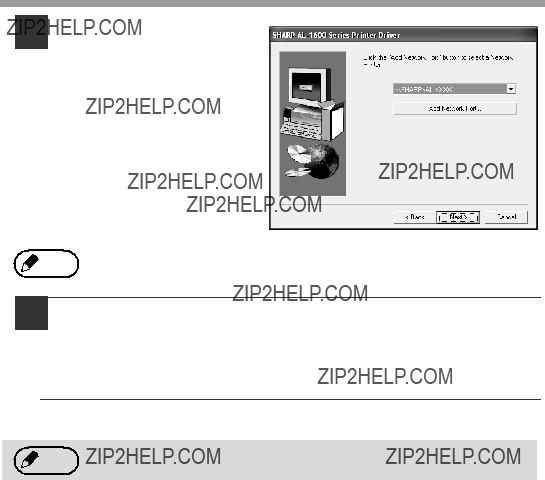
SET UP THE SOFTWARE
8 For the port to be used, select the machine set as a shared printer, and click the "Next" button.
You can also click the "Add Network Port" button and select the printer to be shared (the machine) by browsing the network in the window that appears.
9 When the model selection window appears, select model name of your machine and click the "Next" button.
For the model name of your machine, see the operation panel on the machine.
10
11
Follow the
When the "Finish" screen appears, click the "Close" button.
This completes the installation of the software.
54

SETTING UP BUTTON MANAGER
Button Manager is a software program that works with the scanner driver to enable scanning from the machine.
To scan using the machine, Button Manager must be linked with the scan menu on the machine. Follow the steps below to link Button Manager to scanner events.
Windows XP
1
2
3
Click the "start" button, click "Control Panel", click "Printers and Other Hardware", and then click "Scanners and Cameras".
Click the "SHARP
In the "Properties" screen, click the "Events" tab.
4 Select "SC1:" from the "Select an event"
5
55
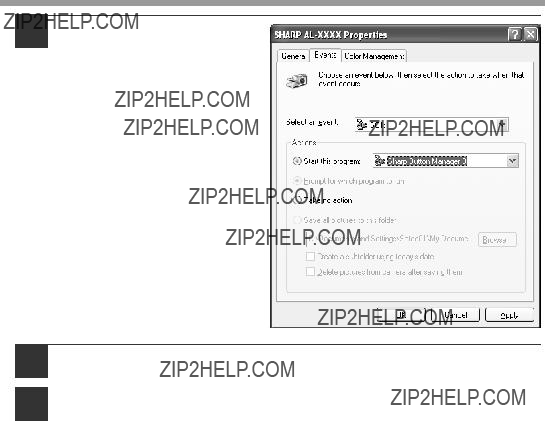
SET UP THE SOFTWARE
5 Select "Start this program" and then select "Sharp Button Manager B" from the
6
7
Click the "Apply" button.
Repeat Steps 4 through 6 to link Button Manager to "SC2:" through "SC6:".
Select "SC2:" from the "Select an event"
When the settings have been completed, click the "OK" button to close the screen.
Button Manager is now linked to the scan menu (1 through 6).
The scan settings for each of scan menu 1 through 6 can be changed with the setting window of Button Manager.
For the factory default settings of the scan menu, see "USING THE SCANNER MODE" (p.61). For the procedures for configuring Button Manager settings, see "Button Manager Settings" in the Online Manual.
56

SET UP THE SOFTWARE
Windows 98/Me/2000
1
2
click the "Start" button, select "Settings", and then click "Control Panel".
3 Select "SHARP
In Windows Me, right click "SHARP
4
5
In the "Properties" screen, click the "Events" tab.
Select "SC1:" from the "Scanner events"
5
57
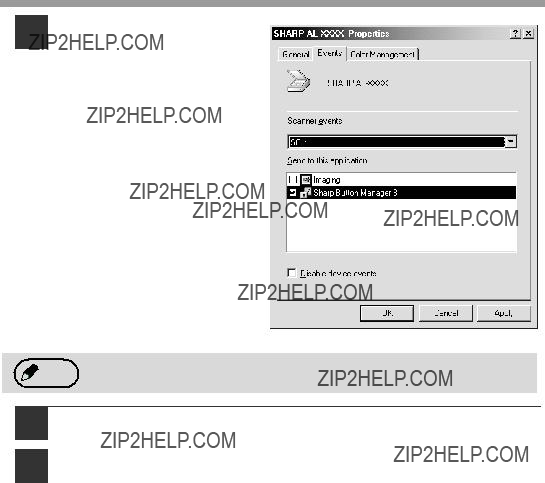
SET UP THE SOFTWARE
6 Select "Sharp Button Manager B" in "Send to this application".
7
8
Click the "Apply" button.
Repeat Steps 5 through 7 to link Button Manager to "SC2:" through "SC6:".
Select "SC2:" from the "Scanner events"
When the settings have been completed, click the "OK" button to close the screen.
Button Manager is now linked to the scan menu (1 through 6).
The scan settings for each of scan menus 1 through 6 can be changed with the setting window of Button Manager.
For the factory default settings of the scan menu, see "USING THE SCANNER MODE" (p.61). For the procedures for configuring Button Manager settings, see "Button Manager Settings" in the Online Manual.
58
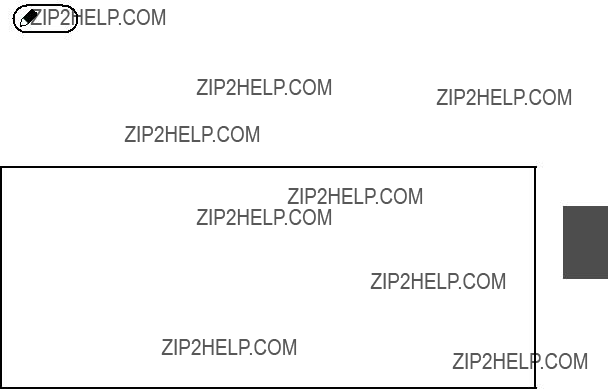
The machine includes a USB connector and a LAN connector as standard equipment. When the USB connector is used, the printer and scanner functions can be used. When the LAN connector is used, the printer function can be used.
The machine has the following features:
???
???ROPM* function
*ROPM is an acronym for "Rip Once Print Many" processing. The ROPM function stores multiple pages of print data in memory before printing. When printing multiple copies, this eliminates the need for the computer to repeatedly transmit the print data.
To use the machine as a printer or scanner, the printer driver or scanner driver must first be installed as explained in the "SET UP THE SOFTWARE".
???The "USB 2.0 MODE SWITCH" setting in the machine's user programs must be set to
user programs. (p.68).
*Even when the Microsoft USB 2.0 driver is installed, some USB 2.0 expansion cards are not capable of attaining the speed stipulated by the
59

USING THE PRINTER MODE
The procedure for loading paper for printing is the same as for loading copy paper. See "LOADING PAPER" (p.18).
??? Print jobs received while the machine is copying will be stored in Note memory. When the copy job is finished, the print jobs will begin
printing.
???Printing is not possible when the front or side cover is opened for machine maintenance, or when a misfeed occurs or the machine runs out of paper or toner, or when the drum cartridge reaches its replacement time.
BASIC PROCEDURE FOR PRINTING
The basic procedure for printing is explained in the following. To use convenient printer functions, see the "Online Manual" or the printer driver help file.
1 Make sure that paper is loaded in the tray.
The procedure for loading paper is the same as for copying. See "LOADING PAPER" (p.18) and make sure that the paper you wish to use is loaded.
2
3
Open the file that you wish to print and select "Print" from the File menu.
Make sure that the printer driver for the machine is selected, and select print settings in the printer driver.
For information on the settings in the printer driver, see the "Online Manual" or the printer driver help file.
4 Click the "Print" button or the "OK" button to begin printing.
The print job will be delivered to the paper output tray.
Canceling a print job
To cancel a print job, select printer mode with the [MODE SELECT] key on the operation panel of the machine, and then press the [CLEAR] key ( ) or the [CLEAR ALL] key (
) or the [CLEAR ALL] key ( ).
).
For limitations on copying in print mode, scanner mode limitations, and Note print mode limitations in copy and scanner mode, see "OPERATION IN
60

USING THE SCANNER MODE
The procedure for placing the original is the same as for copying. See "NORMAL COPYING" (p.24).
Scanner mode cannot be used at the following times:
Note ??? A misfeed has occurred (paper misfeed or original misfeed in the RSPF).
???The user programs are being used.
???The tray paper size is being set.
???The machine is being used in copy mode.
???The front cover or side cover is open.
SCANNING USING THE KEYS ON THE MACHINE
When scanning is performed by this method, the application that has been set in Button Manager will automatically start and the scanned image will be pasted into the application.
Scanning from the operation panel of the machine
1
2
3
The " " indicator lights up to indicate that scanner mode is selected.
" indicator lights up to indicate that scanner mode is selected.
4 Press the [START] key ( ) to begin scanning.
) to begin scanning.
61
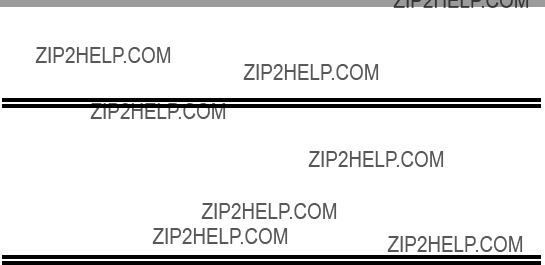
PRINTER/SCANNER FUNCTIONS
Button Manager scan menu
For information on Button Manager settings, see the Button Manager help file. The names in the Button Manager menu ("xxxx" in "SC1:xxxx", etc.) can be changed. See the online manual.
SCANNING FROM YOUR COMPUTER
The machine supports the TWAIN standard, making it possible to scan from TWAIN- compliant applications. The machine also supports WIA (Windows Image Acquisition), making it possible to scan from the "Scan and Camera Wizard" in Windows XP. See the Online Manual for the procedures for TWAIN and WIA scanning. For information on TWAIN and WIA settings, see the help file for the scanner driver or Windows Help.
OPERATION IN COPY, PRINTER, AND SCANNER
MODES
Some operations cannot be performed simultaneously when the machine is being used in printer mode, copy mode, or scanner mode.
*1 During
*2 Printing is possible while scanning is taking place. Printing begins after scanning ends when connected by the LAN connector.
*3 Scanning begins after printing ends when connected by the LAN connector and
62
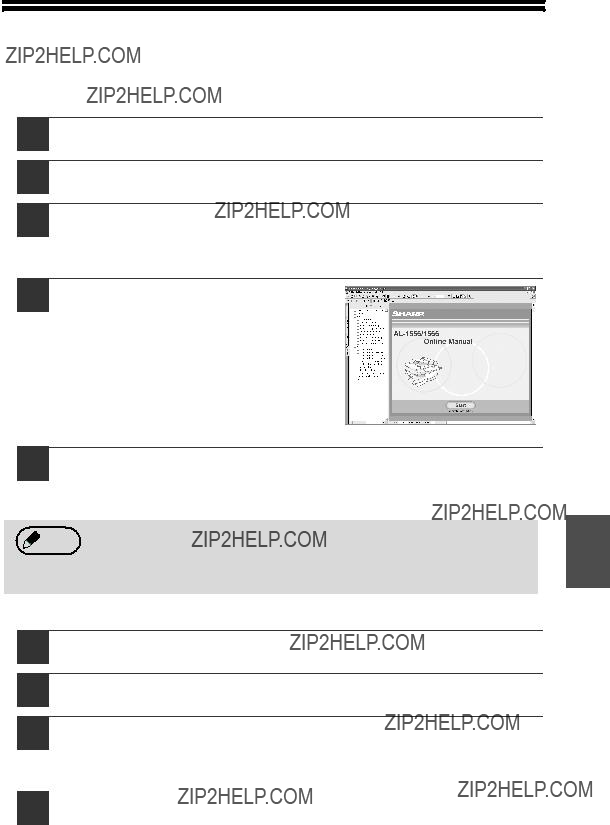
HOW TO USE THE ONLINE MANUAL
The online manual provides detailed instructions for operating the unit as a printer and scanner. It also provides methods for dealing with printing or scanner problems. To access the online manual, your computer must have Acrobat Reader 5.0 or later. If this is not installed, refer to "Installing Acrobat Reader" (below).
1
2
3
Turn on your computer.
Insert the supplied
Click the "start" button, click "My Computer" (  ), and then
), and then  ) icon.
) icon.
In Windows 95/98/Me/NT 4.0/2000,
4
and then
5
The window at right will appear.
Click  to read the online manual.
to read the online manual.
To close the online manual, click the (  ) button located at the
) button located at the
functions of Acrobat Reader.
Installing Acrobat Reader
1
2
3
Turn on your computer.
Insert the
Click the "start" button, click "My Computer" (  ), and then
), and then  ) icon.
) icon.
In Windows95/98/Me/NT4.0/2000,
4
Follow the
63

The user settings allow you to customize machine settings to better meet your needs.
USER PROGRAMS
The user settings consist of the following items.
To change the user program settings as explained in "SELECTING A SETTING FOR A USER PROGRAM" (p.69).
Copy mode
64
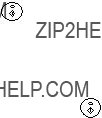
65

USER SETTINGS
66
67

USER SETTINGS
Print mode
*1The scanning speed increases when the USB 2.0 mode is set to
68

SELECTING A SETTING FOR A USER PROGRAM
1 Press the [MENU] key and then press the [OK] key.
In printer mode, the user programs are accessed by simply pressing the [MENU] key.
MAIN MENU
1:USER PROGRAM
SP. FUNC
2
Press the [ ] key (
] key (  ) or [
) or [ ] key (
] key ( ) to select the item that you wish to configure in the USER PROGRAM items, and then press the [OK] key.
) to select the item that you wish to configure in the USER PROGRAM items, and then press the [OK] key.
???See "USER PROGRAM" (p.64 to p.68) for the program name and program code.
???You can also select a program by directly entering the program number with the numeric keys.
USER PROGRAM
2:PREHEAT MODE
 1,2,3, 1,2,3,
1,2,3, 1,2,3,
SP. FUNC
3
Press the [ ] key (
] key (  ) or [
) or [ ] key (
] key ( ) to change the setting of the selected item.
) to change the setting of the selected item.
See "USER PROGRAM" (p.64 to p.68) for the program code.
PREHEAT MODE 1:30 SEC
 1,2,3, 1,2,3,
1,2,3, 1,2,3,
SP. FUNC
4 Press the [OK] key.
When "AE LEVEL ADJUST" is selected in the user programs and the Note [OK] key is pressed, the automatic exposure adjustment screen
appears. Adjust the exposure and press the [OK] key
69

USER SETTINGS
Audible signals (key entry beep, invalid key beep, base setting beep)
The machine sounds three different types of beep signals: a key entry beep that sounds when a valid key is pressed, an invalid key beep that sounds when an invalid key is pressed, and a base setting beep that sounds when a setting is the same as the base setting (base settings are explained below). The base setting beep is initially disabled. If you wish to enable the base setting beep, see "SOUND AT DEFAULT" on page 67. If you wish to change the volume of the beep signals or disable them, see "KEY TOUCH SOUND" on page 66.
The beep patterns of each type of beep signal are as follows:
Base settings
The base settings are preset standard selections for each copy setting. The base settings are as follows:
70

Problems related to general use of the machine, the copy function, and software setup are explained here. Be sure to check the problem carefully before calling for service, as many problems can be solved by the user.
If you are unable to solve the problem, turn off the main switch, unplug the power cord from the outlet, and contact your dealer.
DISPLAY MESSAGES
When the following indicators light up or blink on the operation panel or the following alphanumeric codes appear in the display, solve the problem immediately referring to both the table below and the indicated page.
71
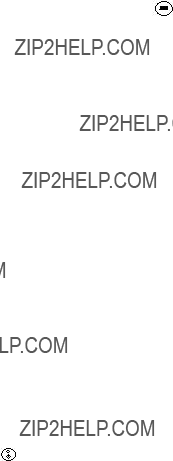
TROUBLESHOOTING AND MAINTENANCE
72

TROUBLESHOOTING THE MACHINE
The following problems are related to the general operation of the machine and copying.
???Place the original face up in the RSPF or face down on the document glass.
73
TROUBLESHOOTING AND MAINTENANCE
74
TROUBLESHOOTING AND MAINTENANCE
75

TROUBLESHOOTING AND MAINTENANCE
76

PROBLEMS DURING SETUP THE SOFTWARE
If the software does not install correctly, check the following items on your computer. To remove the software, see "Removing the software" (p.79)
MFP driver cannot be installed (Windows 2000/XP)
If the MFP driver cannot be installed in Windows 2000/XP, follow these steps to check your computer's settings.
1 Click the "start" button and then click "Control Panel".
In Windows 2000, click the "Start" button, select "Settings", and then click "Control Panel".
2 Click "Performance and Maintenance", and then click "System".
In Windows 2000,
3
4
Click the "Hardware" tab and then click the "Driver Signing" button.
Check "What action do you want Windows to take?" ("File signature verification" in Windows 2000).
If "Block" has been selected, it will not be possible to install the MFP driver. Select "Warn" and then install the MFP driver as explained in "INSTALLING THE SOFTWARE".
8
77

TROUBLESHOOTING AND MAINTENANCE
Plug and play screen does not appear (USB only)
If the Plug and Play screen does not appear after you connect the machine to your computer with a USB cable and turn on the machine, follow the steps below to verify that the USB port is available.
1 Click the "start" button, click "Control Panel", and then click "Performance and Maintenance".
In Windows 98/Me/2000, click the "Start" button, select "Settings", and then click "Control Panel".
2 Click "System", click the "Hardware" tab, and click the "Device Manager" button.
"Universal Serial Bus controllers" will appear in the list of devices.
???In Windows 2000,
???If the "System" icon does not appear in Windows Me, click "view all Control Panel options".
3
4
Click the  icon beside "Universal Serial Bus controllers".
icon beside "Universal Serial Bus controllers".
Two items should appear: your controller chipset type and Root Hub. If these items appear, you can use the USB port. If the "Universal Serial Bus controllers" shows a yellow exclamation point or does not appear, you must check your computer manual for USB troubleshooting or contact your computer manufacturer.
Once you have verified that the USB port is enabled, install the software as explained in "INSTALLING THE SOFTWARE".
78
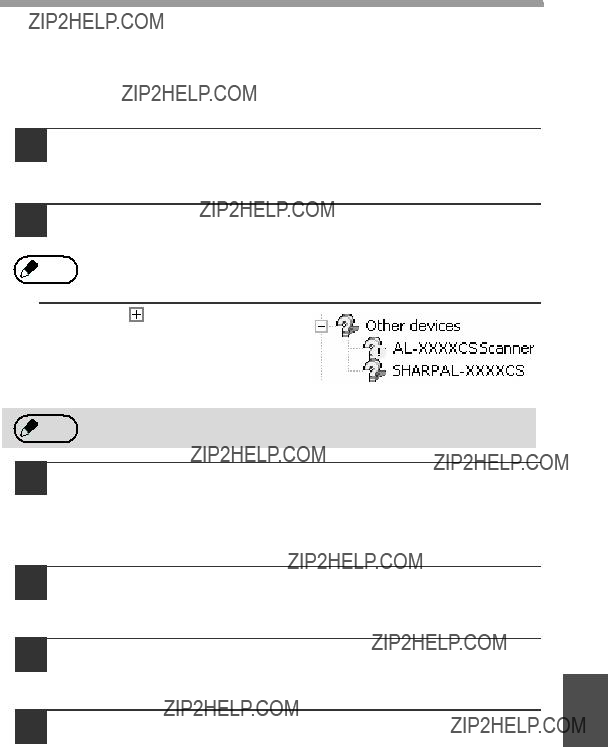
TROUBLESHOOTING AND MAINTENANCE
The MFP driver cannot be correctly installed by Plug and Play (Windows 2000/XP) (USB only)
In Windows 2000/XP, if the MFP driver cannot be correctly installed by Plug and Play (for example, Plug and Play takes place without copying the required files for the MFP driver installation), follow these steps to remove unneeded devices and then install the MFP driver as explained in "SET UP THE SOFTWARE" (p.40).
1 Click the "start" button, click "Control Panel", and then click "Performance and Maintenance".
In Windows 2000, click the "Start" button, select "Settings", and then click "Control Panel".
2 Click "System", click the "Hardware" tab, and click the "Device Manager" button.
If
Other devices
If "Other devices" does not appear, close the "Device Manager" Note window.
4 Install the software as explained in "INSTALLING THE SOFTWARE".
Removing the software
If you need to remove the software, follow these steps.
1
2
3
Click the "start" button and then click "Control Panel".
In Windows 95/98/Me/NT 4.0/2000, click the "Start" button, select "Settings", and then click "Control Panel".
Click "Add or Remove Programs".
and Button Manager from the list, and remove the software.
For more information, refer to your operating manual or to the help files for your operating system.
79
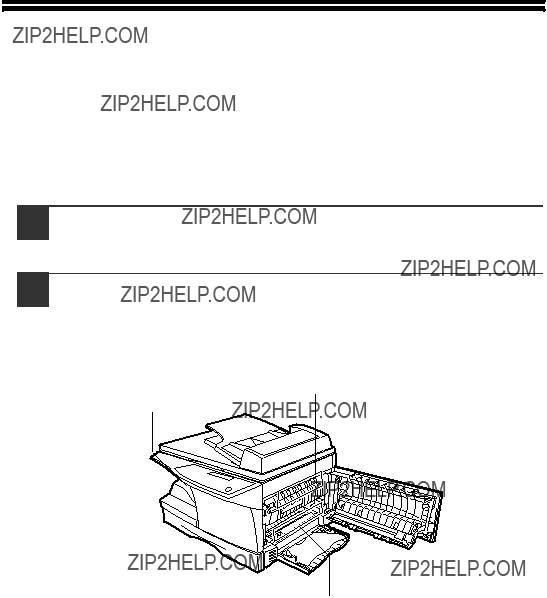
MISFEED REMOVAL
When a misfeed occurs, the error indicator blinks, "CLEAR PAPER JAM" appears in the display, and the machine stops operating. If a misfeed occurs when using the RSPF, "RETURN X ORIGINAL(S) START TO RESUME" will appear in the display. ("X" indicates the number of pages to be returned.). This indicates the number of the originals that must be returned to the document feeder tray after a misfeed. Return the required number of originals. This number will be cleared when copying is resumed or the [CLEAR] key ( ) is pressed. If an original misfeed occurs in the RSPF, the machine will stop and the error indicator will blink. To remove a misfeed from the RSPF, see "D: Misfeed in the RSPF" (p.83).
) is pressed. If an original misfeed occurs in the RSPF, the machine will stop and the error indicator will blink. To remove a misfeed from the RSPF, see "D: Misfeed in the RSPF" (p.83).
1 Open the bypass tray and side cover, in that order.
To open the bypass tray, see "Loading paper in the bypass tray" (p.22). To open the side cover, see "INSTALLING THE TD CARTRIDGE" (p.14).
2 Check the misfeed location. Remove the misfed paper following the instructions for each location in the illustration below. If the error indicator blinks, proceed to "A: Misfeed in the paper feed area" (p.81).
If the misfed paper is seen from this side, proceed to "C: Misfeed in the transport area". (p.82)
If paper is misfed here, proceed to "B: Misfeed in the fusing area". (p.81)
If paper is misfed here, proceed to "A: Misfeed in the paper feed area". (p.81)
80
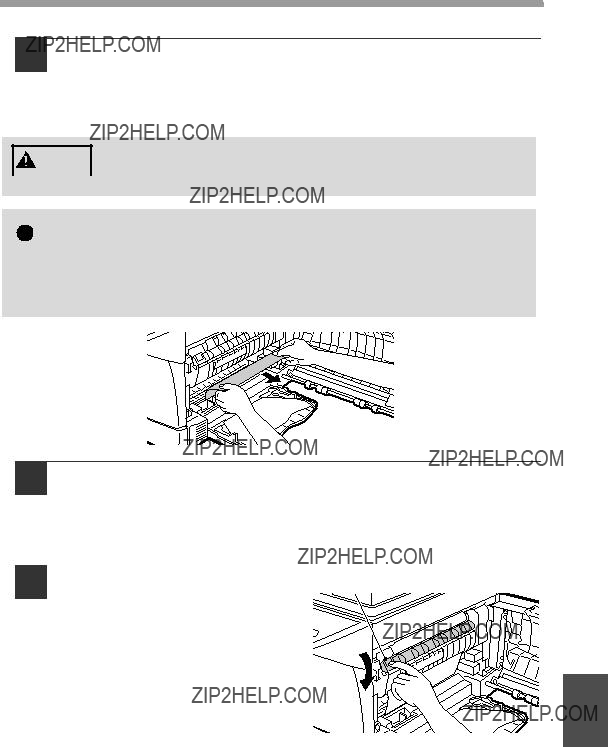
TROUBLESHOOTING AND MAINTENANCE
A:Misfeed in the paper feed area
1Gently remove the misfed paper from the paper feed area as shown in the illustration. If the error indicator blinks and the misfed paper is not visible in the paper feed area, pull out the paper tray and remove the misfed paper. If the paper cannot be removed, proceed to "B: Misfeed in the fusing area".
The fusing unit is hot. Do not touch the fusing unit when
???If the paper has been fed through the bypass tray, do not remove the misfed paper through the bypass tray. Toner on the paper may stain the paper transport area, resulting in smudges on copies.
8
81
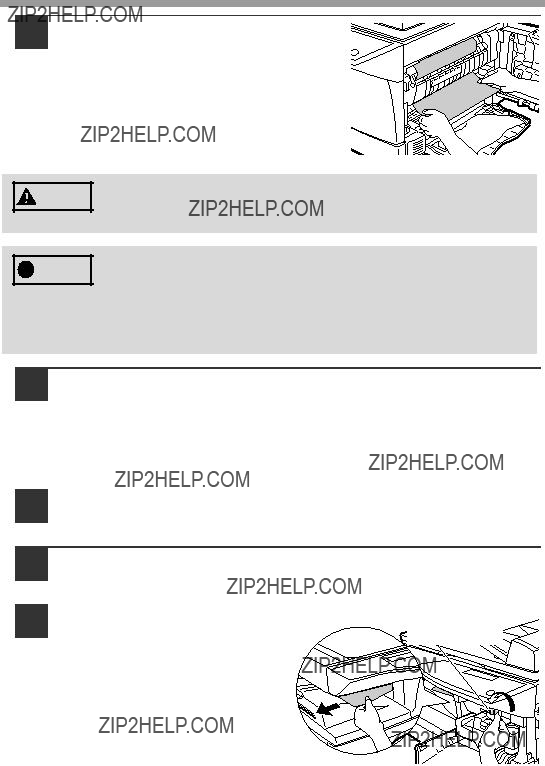
TROUBLESHOOTING AND MAINTENANCE
2 Gently remove the misfed paper from under the fusing unit as shown in the illustration. If the paper cannot be removed, proceed to "C: Misfeed in the transport area".
The fusing unit is hot. Do not touch the fusing unit when Warning removing misfed paper. Doing so may cause a burn or other
injury.
??? Do not touch the surface of the drum (green portion) of the drum  Caution cartridge when removing the misfed paper. Doing so may cause
Caution cartridge when removing the misfed paper. Doing so may cause
smudges on copies.
???Do not remove the misfed paper from above the fusing unit. Unfixed toner on the paper may stain the paper transport area, resulting in smudges on copies.
3 Raise the fusing unit release lever and then close the side cover by pressing the round projections near the side cover open button. The error indicator will go out and the ready indicator will light up.
C:Misfeed in the transport area
1Lower the fusing unit release lever.
2
3
82

TROUBLESHOOTING AND MAINTENANCE
4 Raise the fusing unit release lever, close the front cover and then close the side cover by pressing the round projections near the side cover open button. The error indicator will go out and the ready indicator will light up.
When closing the covers, be sure to close the front cover securely and  Caution then close the side cover. If the covers are closed in the wrong order,
Caution then close the side cover. If the covers are closed in the wrong order,
the covers may be damaged.
D: Misfeed in the RSPF
An original misfeed may occur at one of three locations: if the misfed original is visible in the document feeder tray, (A) in the document feeder tray; if the misfed original is not visible in the document feeder tray, (B) in the exit area or (C) under the document feeder cover. Remove the misfed original following the instructions for each location.
(A)Open the document feeder cover and pull the original gently to the left and out from the document feeder tray. Close the document feeder cover. Open and close the RSPF to clear the error indicator. If the misfed original cannot be easily removed, proceed to (C).
Document feeder cover
(B)Open the RSPF and rotate the roller to remove the misfed original from the exit area. If the misfed original cannot be easily removed, proceed to (C).
 Roller
Roller
With the RSPF, pull out the reversing tray to remove the misfed original.
Reversing tray
83

TROUBLESHOOTING AND MAINTENANCE
(C)If the original does not move easily into the exit area, remove it in the direction of the arrow while rotating the roller.
"RETURN X ORIGINAL(S) START TO RESUME" will appear in the Note display. Return the indicated number of pages to the document feeder
tray. Open and close the RSPF to clear the error indicator, and then return the required number of originals. Press the [START] key (  ) to resume copying.
) to resume copying.
84
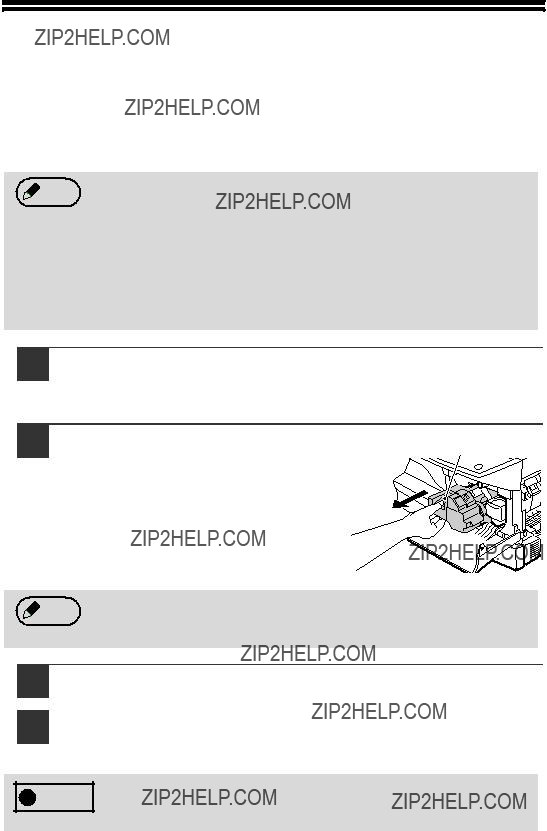
TD CARTRIDGE REPLACEMENT
When toner is low, the error indicator will light up and "TONER IS LOW" will appear in the display. For information on purchasing a new TD cartridge, see "ABOUT SUPPLIES AND OPTIONS" (p.91). If copying is continued while the indicator is lit, copies will gradually become lighter until the toner runs out. When the toner runs out, the machine will stop operating, the error indicator will blink, and "REPLACE THE TD CARTRIDGE" will appear in the display. Follow the procedure below to replace the TD cartridge.
??? After the machine stops, it may be possible to make a few more Note copies by taking the TD cartridge out of the machine, shaking it
horizontally, then reinstalling it. If copying is not possible after this operation, replace the TD cartridge.
???During a long copy run of a dark original, "TONER REPLENISHMENT IN PROGRESS" appears in the display, and the machine may stop even though toner is left. The machine will feed
toner up to 2 minutes and then the ready indicator will light up. Press the [START] key (  ) to resume copying.
) to resume copying.
1Open the bypass tray, side cover, and front cover, in that order.
To open the bypass tray, see "Loading paper in the bypass tray" (p.22). To open the side cover and front cover, see "INSTALLING THE TD CARTRIDGE" (p.14).
2Gently pull the TD cartridge out
while pressing the lock releaseLock release button
button.
In order to help preserve the global environment, we recycle used TD Note cartridges. Please read "COPIER TONER CARTRIDGE RECYCLING
PROGRAM", which is enclosed in the new TD cartridge package.
3
4
When closing the covers, be sure to close the front cover securely and  Caution then close the side cover. If the covers are closed in the wrong order,
Caution then close the side cover. If the covers are closed in the wrong order,
the covers may be damaged.
85
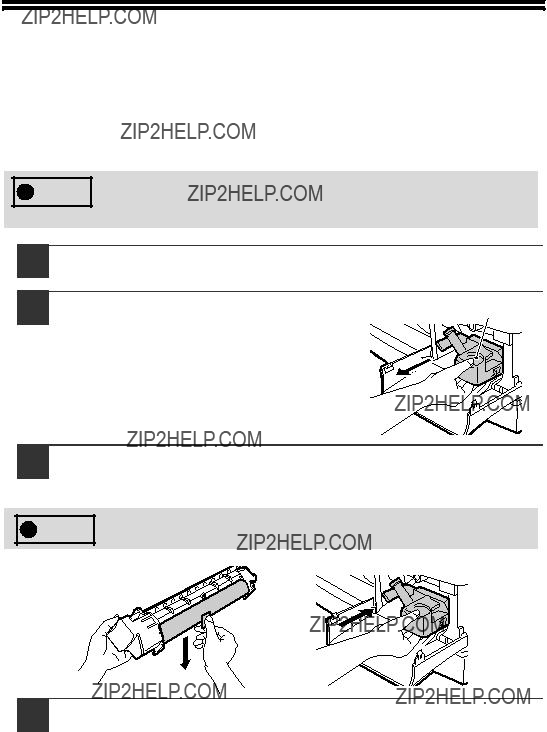
DRUM CARTRIDGE REPLACEMENT
The useful life of the drum cartridge is approximately 18,000 copies. When the internal counter reaches approximately 17,000 copies, the error indicator will light up and "A DRUM CARTRIDGE WILL BE NEEDED SOON" will appear in the display. For more information on purchasing a drum cartridge, see "ABOUT SUPPLIES AND OPTIONS" (p.91). When the error indicator blinks and "REPLACE THE DRUM CARTRIDGE" appears in the display, the machine will stop operating until the cartridge is replaced. Replace the drum cartridge at this time.
Do not remove the protective cover on the drum portion (black paper) of  Caution a new drum cartridge before use. The cover protects the drum against
Caution a new drum cartridge before use. The cover protects the drum against
external light.
1
2
3
Remove the TD cartridge (see "TD CARTRIDGE REPLACEMENT" (p.85)).
Remove the new drum cartridge from the protective bag and remove the protective cover from the cartridge. Gently install the new drum cartridge.
4 Gently install the TD cartridge. To install the TD cartridge, see "INSTALLING THE TD CARTRIDGE" (p.14).
86
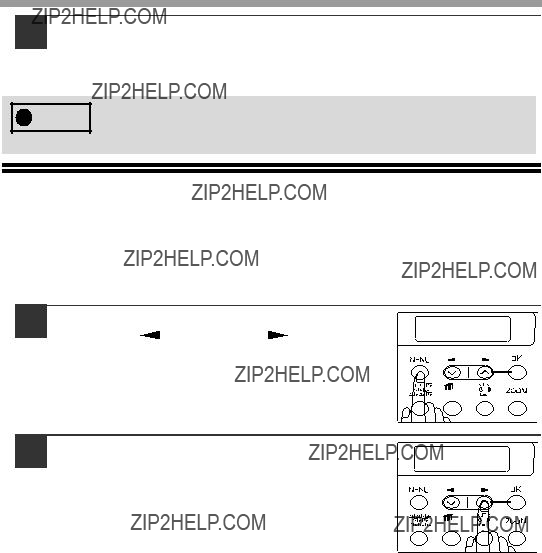
TROUBLESHOOTING AND MAINTENANCE
5 Close the front cover and then the side cover by pressing the round projections near the side cover open button. The drum replacement required error indicator will go out and the ready indicator will light up.
When closing the covers, be sure to close the front cover securely and  Caution then close the side cover. If the covers are closed in the wrong order,
Caution then close the side cover. If the covers are closed in the wrong order,
the covers may be damaged.
CHECKING THE TOTAL COUNT AND DRUM
CARTRIDGE LIFE
You can check the total number of pages output by the machine (all pages printed by the copy function and printer function), as well as the output counts of each function (number of copies, number of scanned pages, number of faxes, etc.) and drum cartridge life. When a count reaches 999,999 it returns to 0.
1 Press the [MENU] key.
Press the [ ] key (  ) or [ ] key (
) or [ ] key ( ) until "TOTAL COUNT" appears, and then press the [OK] key.
) until "TOTAL COUNT" appears, and then press the [OK] key.
MAIN MENU
3:TOTAL COUNT
 1,2,3,
1,2,3,  1,2,3,
1,2,3,
SP. FUNC
2 Press the [ ] key (
] key (  ) or [
) or [ ] key (
] key ( ) to display the count of each function.
) to display the count of each function.
TOTAL OUTPUT
012,345
 1,2,3,
1,2,3,  1,2,3,
1,2,3,
SP. FUNC
The count of each function changes as follows each the [ ] key (
] key (  ) or [
) or [ ] key (
] key (  )is pressed:
)is pressed:
87

CLEANING THE MACHINE
Proper care is essential in order to get clean, sharp copies. Be sure to take a few minutes to clean the machine on a regular basis.
Do not spray flammable cleaner gas. Gas from the spray may Warning come in contact with the internal electrical components or high-
temperature parts of the fusing unit, creating a risk of fire or electrical shock.
???Do not use thinner, benzene or other volatile cleaning agents. Doing so may cause deformation, discoloration, deterioration or malfunction.
Cabinet
Wipe the cabinet with a soft, clean cloth.
Document glass and the back side of the RSPF
Stains on the glass, RSPF scanning window, cover or RSPF roller will also be copied. Wipe the glass, RSPF scanning window, cover and RSPF roller with a soft, clean cloth. If necessary, dampen the cloth with a glass cleaner.
RSPF roller
RSPF
Scanning window
88

TROUBLESHOOTING AND MAINTENANCE
TD cartridge and drum cartridge
1
2
Remove the TD cartridge and drum cartridge as explained in "TD CARTRIDGE REPLACEMENT" (p.85) and "DRUM CARTRIDGE REPLACEMENT" (p.86).
Wipe the parts of the TD cartridge and drum cartridge shown below with a clean cloth.
Wipe only the parts that are indicated in the illustration.
???When cleaning the TD cartridge, do not?? tilt or shake it. Toner may spill out and soil your clothes.
3 Replace the TD cartridge and drum cartridge as explained in "TD CARTRIDGE REPLACEMENT" (p.85) and "DRUM CARTRIDGE REPLACEMENT" (p.86).
If copies start becoming streaky or blotchy, the transfer charger may be dirty. Clean the charger using the following procedure.
8
89

TROUBLESHOOTING AND MAINTENANCE
Transfer charger
1
2
3
Turn the power switch off. (p.17)
Ensure that the bypass tray is open and then open the side cover while pressing the side cover open button.
Take the charger cleaner out by holding the tab. Set the charger cleaner onto the right end of the transfer charger, gently slide the cleaner to the left end, and then remove it. Repeat this operation two or three times.
Slide the charger cleaner from the right end to the left end along the Note groove of the transfer charger. If the cleaner is stopped on the way,
smudges on copies may occur.)
90
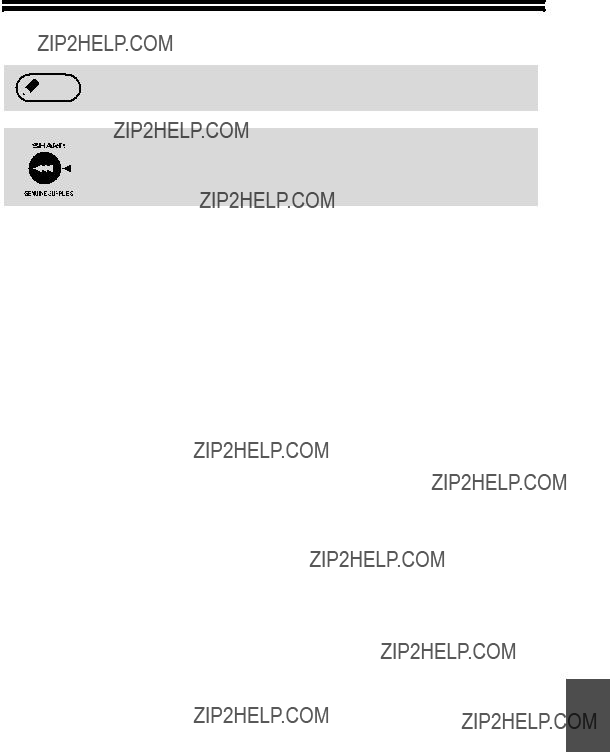
ABOUT SUPPLIES AND OPTIONS
When ordering supplies, please use the correct part numbers as listed below.
 Note Be sure to use only genuine SHARP parts and supplies.
Note Be sure to use only genuine SHARP parts and supplies.
For best copying results, be sure to use only SHARP Genuine Supplies which are designed, engineered, and tested to maximize the life and performance of SHARP copiers. Look for the Genuine Supplies label on the toner package.
Supply list
*Based on copying onto
(The life of the TD cartridge which has been included in the machine at the factory is approximately 2,000 sheets.)
Interface cable
Please purchase the appropriate cable for your computer.
USB interface cable
USB cable that supports USB 2.0.
LAN interface cable
Shielded type cable.
8
91

92

*1 The
*2 Not including TD and drum cartridges.
9
93

APPENDIX
Printer Function
94
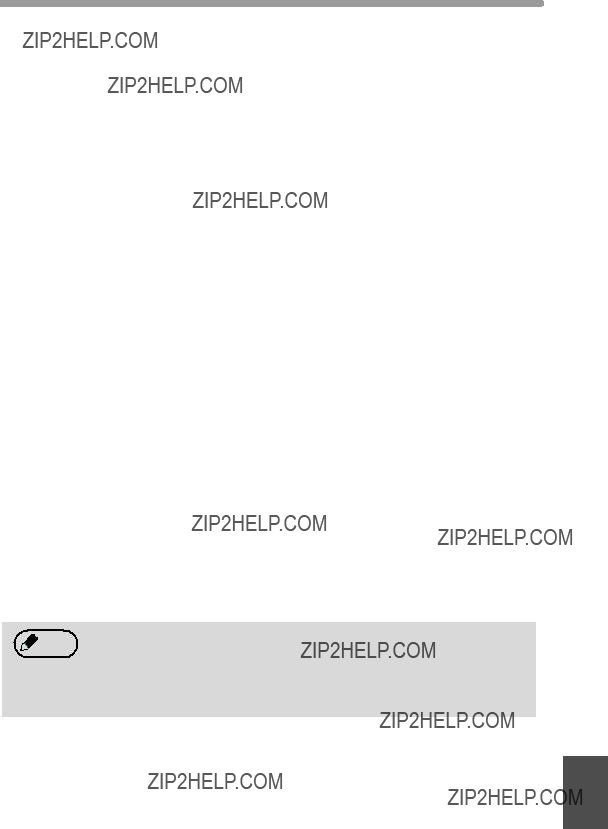
APPENDIX
Scanner Function
As a part of our policy of continuous improvement, SHARP reserves Note the right to make design and specification changes for product
improvement without prior notice. The performance specification figures indicated are nominal values of production units. There may be some deviations from these values in individual units.
9
95
SOFTWARE LICENSE
PLEASE READ THIS LICENSE CAREFULLY BEFORE USING THE SOFTWARE. BY
USING THE SOFTWARE, YOU ARE AGREEING TO BE BOUND BY THE TERMS OF
THIS LICENSE. 1. License.
The application, demonstration, system and other software accompanying this License, whether on disk, in read only memory, or on any other media (the "Software") and related documentation are licensed to you by SHARP. You own the disk on which the Software is recorded but SHARP and/or SHARP'S Licensors retain title to the Software and related documentation. This License allows you to use the Software on one or more computers connected to a single printer and make one copy of the Software in
2. Restrictions.
The Software contains copyrighted material, trade secrets and other proprietary material which is owned by SHARP and/or its Licensors and in order to protect them you may not decompile, reverse engineer, disassemble or otherwise reduce the Software to a
3. Termination.
This license is effective until terminated. You may terminate this License at any time by destroying the Software and related documentation and all copies thereof. This License will terminate immediately without notice from SHARP and/or SHARP???S Licensors if you fail to comply with any provision of this License. Upon termination you must destroy the Software and related documentation and all copies thereof.
4. Export Law Assurances.
You agree and certify that neither the Software nor any other technical data received from SHARP, nor the direct product thereof, will be exported outside the United States except as authorized and as permitted by the laws and regulations of the United States. If the Software has been rightfully obtained by you outside of the United States, you agree that you will not
5. Government End Users.
If you are acquiring the Software on behalf of any unit or agency of the United States Government, the following provisions apply. The Government agrees:
(i)if the Software is supplied to the Department of Defense (DoD), the Software is classified as "Commercial Computer Software" and the Government is acquiring only "restricted rights" in the Software and its documentation as that term is defined in Clause
(ii)if the Software is supplied to any unit or agency of the United States Government other than DoD, the Government's rights in the Software and its documentation will be as defined in Clause 52.227- 19 (c)(2) of the FAR or, in the case of NASA, in Clause
96
6. Limited Warranty on Media.
SHARP warrants the disks on which the Software is recorded to be free from defects in materials and workmanship under normal use for a period of ninety (90) days from the date of purchase as evidenced by a copy of the receipt. The entire liability of SHARP and/or its Licensors and your exclusive remedy will be replacement of the disk which fails to meet the limited warranty provided by this Clause 6. A disk will be replaced when it is returned to SHARP or a SHARP authorized representative with a copy of the receipt. SHARP will have no responsibility to replace a disk damaged by accident, abuse or misapplication.
ANY IMPLIED WARRANTIES ON THE DISKS, INCLUDING THE IMPLIED WARRANTIES OF
MERCHANTABILITY AND FITNESS FOR A PARTICULAR PURPOSE, ARE LIMITED IN
DURATION TO NINETY (90) DAYS FROM THE DATE OF DELIVERY. THIS WARRANTY GIVES
YOU SPECIFIC LEGAL RIGHTS, AND YOU MAY ALSO HAVE OTHER RIGHTS WHICH VARY
FROM JURISDICTION TO JURISDICTION.
7. Disclaimer of Warranty on Software.
You expressly acknowledge and agree that use of the Software is at your sole risk. The software and related documentation are provided "AS IS" and without warranty of any kind and SHARP and SHARP'S Licensor(s) (for the purpose of provisions 7 and 8, SHARP and SHARP'S Licensor(s) shall be collectively referred to as "SHARP") EXPRESSLY DISCLAIM ALL WARRANTIES, EXPRESS OR
IMPLIED, INCLUDING, BUT NOT LIMITED TO, THE IMPLIED WARRANTIES OF
MERCHANTABILITY AND FITNESS FOR A PARTICULAR PURPOSE. SHARP DOES NOT
WARRANT THAT THE FUNCTIONS CONTAINED IN THE SOFTWARE WILL MEET YOUR
REQUIREMENTS, OR THAT THE OPERATION OF THE SOFTWARE WILL BE
UNINTERRUPTED OR
CORRECTED. FURTHERMORE, SHARP DOES NOT WARRANT OR MAKE ANY
REPRESENTATIONS REGARDING THE USE OR THE RESULTS OF THE USE OF THE
SOFTWARE OR RELATED DOCUMENTATION IN TERMS OF THEIR CORRECTNESS,
ACCURACY, RELIABILITY, OR OTHERWISE. NO ORAL OR WRITTEN INFORMATION OR
ADVICE GIVEN BY SHARP OR A SHARP AUTHORIZED REPRESENTATIVE SHALL CREATE A
WARRANTY OR IN ANY WAY INCREASE THE SCOPE OF THIS WARRANTY. SHOULD THE
SOFTWARE PROVE DEFECTIVE, YOU (AND NOT SHARP OR A SHARP AUTHORIZED
REPRESENTATIVE) ASSUME THE ENTIRE COST OF ALL NECESSARY SERVICING, REPAIR
OR CORRECTION, SOME JURISDICTIONS DO NOT ALLOW THE EXCLUSION OF IMPLIED
WARRANTIES, SO THE ABOVE EXCLUSION MAY NOT APPLY TO YOU.
8. Limitation of Liability.
UNDER NO CIRCUMSTANCES INCLUDING NEGLIGENCE, SHALL SHARP BE LIABLE FOR
ANY INCIDENTAL, SPECIAL OR CONSEQUENTIAL DAMAGES THAT RESULT FROM THE
USE OR INABILITY TO USE THE SOFTWARE OR RELATED DOCUMENTATION, EVEN IF
SHARP OR A SHARP AUTHORIZED REPRESENTATIVE HAS BEEN ADVISED OF THE
POSSIBILITY OF SUCH DAMAGES. SOME JURISDICTIONS DO NOT ALLOW THE
LIMITATION OR EXCLUSION OF LIABILITY FOR INCIDENTAL OR CONSEQUENTIAL
DAMAGES SO THE ABOVE LIMITATION OR EXCLUSION MAY NOT APPLY TO YOU.
In no event shall SHARP'S total liability to you for all damages, losses, and causes of action (whether in contract, tort (including negligence) or otherwise) exceed the amount paid by you for the Software.
9. Controlling Law and Severability.
For a portion of the Software related with Apple Macintosh and Microsoft Windows, this license shall be governed by and construed in accordance with the laws of the state of California and Washington, respectively. If for any reason a court of competent jurisdiction finds any provision of this License, or portion thereof, to be unenforceable, that provision of the License shall be enforced to the maximum extent permissible so as to effect the intent of the parties, and the remainder of this License shall continue in full force and effect.
10. Complete Agreement.
This License constitutes the entire agreement between the parties with respect to the use of the Software and related documentation, and supersedes all prior or contemporaneous understandings or agreements, written or oral, regarding such subject matter. No amendment to or modification of this License will be binding unless in writing and signed by a duly authorized representative of SHARP.
97
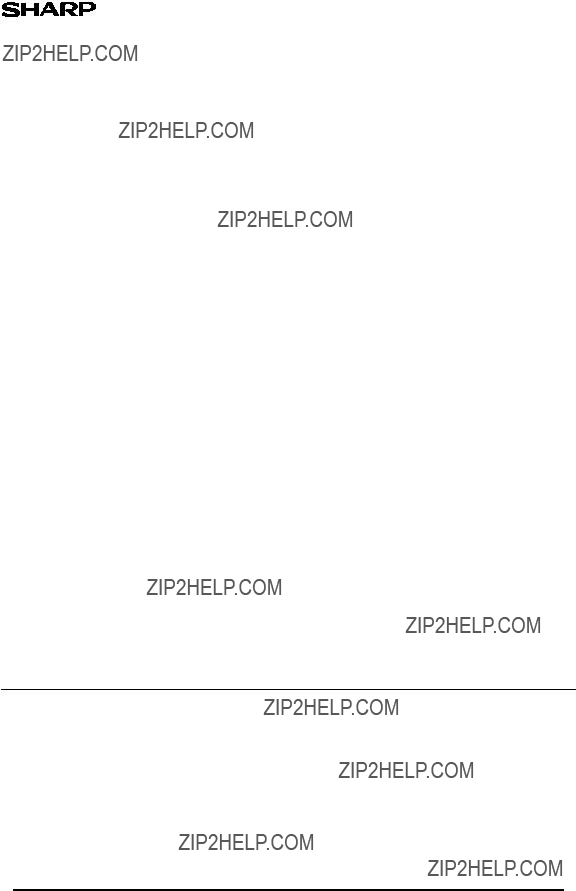
Local suppliers are listed below. Please contact the nearest supplier for additional information.
2.COMPOSITION/INFORMATION ON INGREDIENTS
Substance[ ] Preparation[X]
98

MSDS NO.
3. HAZARDS IDENTIFICATION
Most Important Hazards and Effects of the Products
Human Health Effects :There are no anticipated carcinogenic effects from exposure based on
4.
5. FIRE
6. ACCIDENTAL RELEASE MEASURES
7. HANDLING AND STORAGE
Handling
Technical Measures :None
Precautions :None
Safe Handling Advice :Use of a dust mask is recommended when handling a large quantity of toner or during long term exposure, as with any
:None
:Keep container closed and Store in a cool and dry place. Keep out of the reach of children.
Incompatible Products:None
99
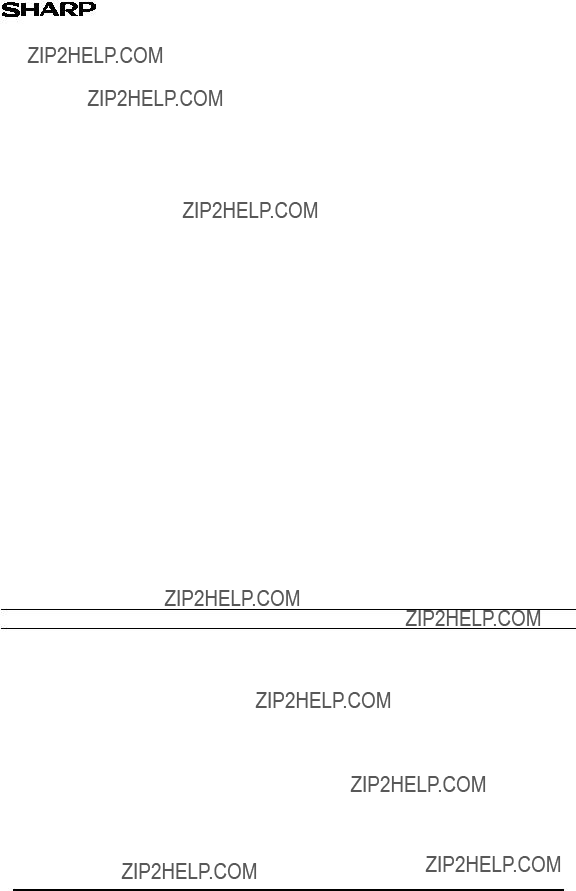
11.TOXICOLOGICAL INFORMATION
Acute Toxicity
Carcinogenicity :In 1996 the IARC reevaluated carbon black as a Group 2B carcinogen (possible human carcinogen). This classification is given to chemicals for which there is inadequate human evidence, but sufficient animal evidence on which to base an opinion of carcinogenicity. The classification is based upon the development of lung tumors in rats receiving chronic inhalation exposures to free carbon black at levels that induce particle overload of the lung. Studies performed in animal models other than rats did not show any association between carbon black and lung tumors. Moreover, a
100
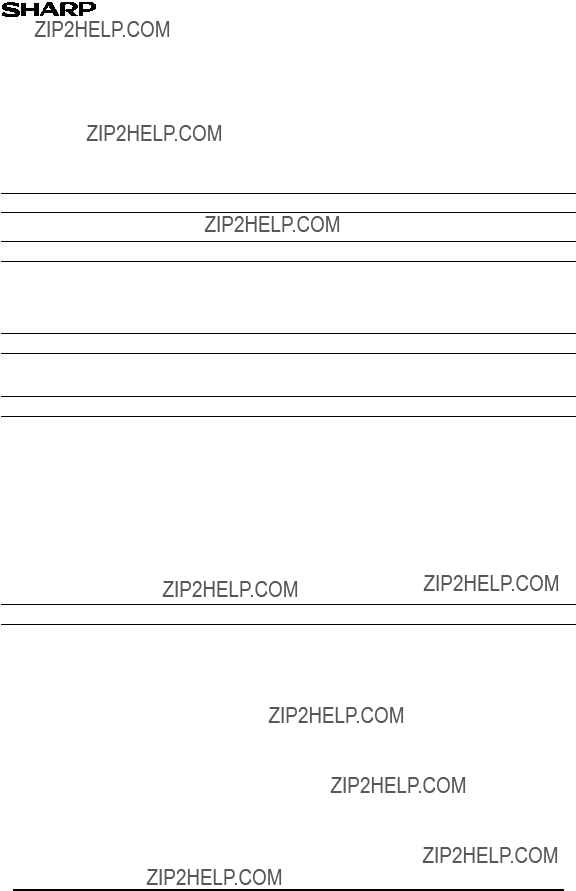
Data Revised: Jul. 31, 2002
Data Issued: Jun. 1, 1998 MSDS NO.
Chronic Effect :In a study in rats of chronic inhalation exposure to a typical toner, a mild to moderate degree of lung fibrosis was observed in 92% of the rats in the high concentration (16mg/m3) exposure group, and a minimal to mild degree of fibrosis was noted in 22% of the animals in the middle (4mg/m3) exposure group, but no pulmonary change was reported in the lowest (1mg/m3) exposure group, the most relevant level to potential human exposures.
12.ECOLOGICAL INFORMATION
No data are available.
13.DISPOSAL CONSIDERATION
Waste from residues :Waste material may be dumped or incinerated under conditions
which meet all federal, state and local environmental regulations. Contaminated Packaging :Waste may be disposed or incinerated under conditions which meet
all federal, state and local environmental regulations.
14. TRANSPORT INFORMATION
UN Classification :None
Not classified as hazardous for transport.
15.REGULATORY INFORMATION
US Information
TSCA (Toxic Substances Control Act) :
All chemical substances in this product comply with all applicable rules or order under TSCA.
SARA (Superfund Amendments and Reauthorization Act) Title III
302 Extreme Hazardous Substance :None
16. OTHER INFORMATION
IARC (1996) :IARC monographs on the Evaluation of the Carcinogenic Risk of Chemicals to Humans, Vol. 65, Printing Process And Printing Inks, Carbon Black and Some Nitro Compounds, Lyon,
H.Muhle, B.Bellmann, O.Creutzenberg, C.Dasenbrock, H.Ernst, R.Kilpper, J.C.MacKenzie, P.Morrow, U.Mohr,
S.Takenaka, and R.Mermelstein (1991) Pulmonary Response to Toner upon Chronic Inhalation Exposure in Rats.
Fundamental and Applied Toxicology 17,
The information on this data sheet represents our current data and best opinion as to the proper use in handling of this product under normal conditions. However, all materials may present unknown hazards and should be used with caution. Although certain hazards are described herein, we do not guarantee that these are the only hazards which exist.
101

Local suppliers are listed below. Please contact the nearest supplier for additional information.
2.COMPOSITION/INFORMATION ON INGREDIENTS
Substance[ ] Preparation[X]
102
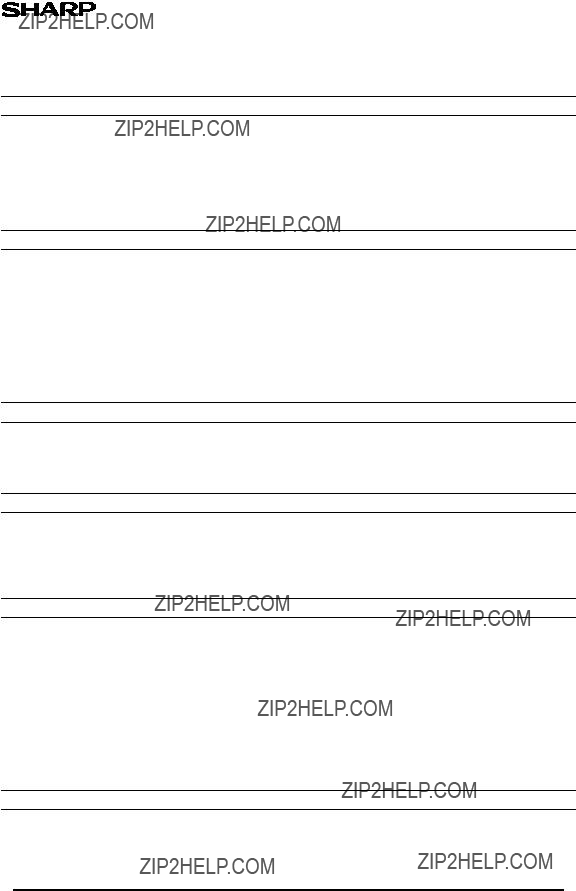
MSDS NO.
3. HAZARDS IDENTIFICATION
Most Important Hazards and Effects of the Products
Human Health Effects :There are no anticipated carcinogenic effects from exposure based on
4.
5. FIRE
6. ACCIDENTAL RELEASE MEASURES
7. HANDLING AND STORAGE
Handling
Technical Measures :None
Precautions :None
Safe Handling Advice :Use of a dust mask is recommended when handling a large quantity of toner or during long term exposure, as with any
:None
:Keep container closed and Store in a cool and dry place. Keep out of the reach of children.
Incompatible Products:None
8. EXPOSURE CONTROL / PERSONAL PROTECTION
103
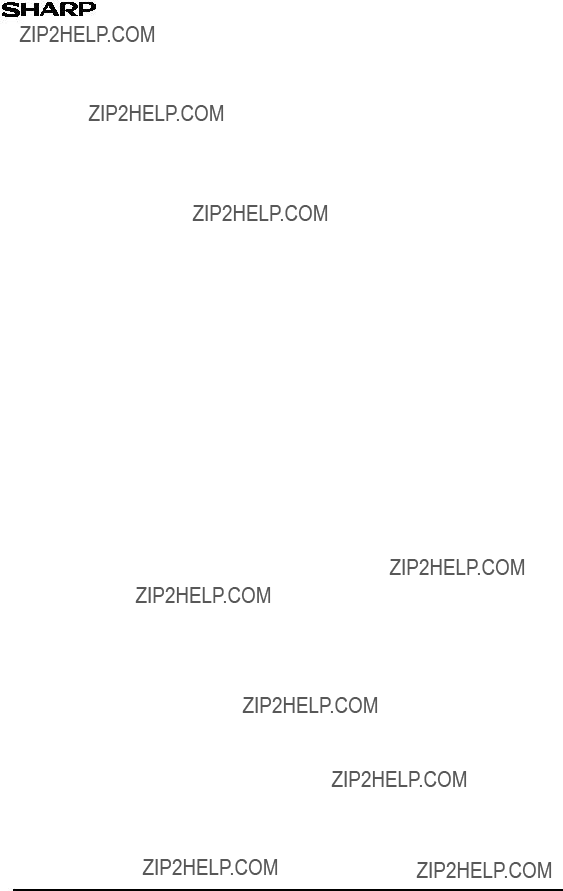
Carcinogenicity :In 1996 the IARC reevaluated carbon black as a Group 2B carcinogen (possible human carcinogen). This classification is given to chemicals for which there is inadequate human evidence, but sufficient animal evidence on which to base an opinion of carcinogenicity. The classification is based upon the development of lung tumors in rats receiving chronic inhalation exposures to free carbon black at levels that induce particle overload of the lung. Studies performed in animal models other than rats did not show any association between carbon black and lung tumors. Moreover, a
Chronic Effect :In a study in rats of chronic inhalation exposure to a typical toner, a mild to moderate degree of lung fibrosis was observed in 92% of the rats in the high concentration (16mg/m3) exposure group, and a minimal to mild degree of fibrosis was noted in 22% of the animals in the middle (4mg/m3) exposure group, but no pulmonary change was reported in the lowest (1mg/m3) exposure group, the most relevant level to potential human exposures.
104
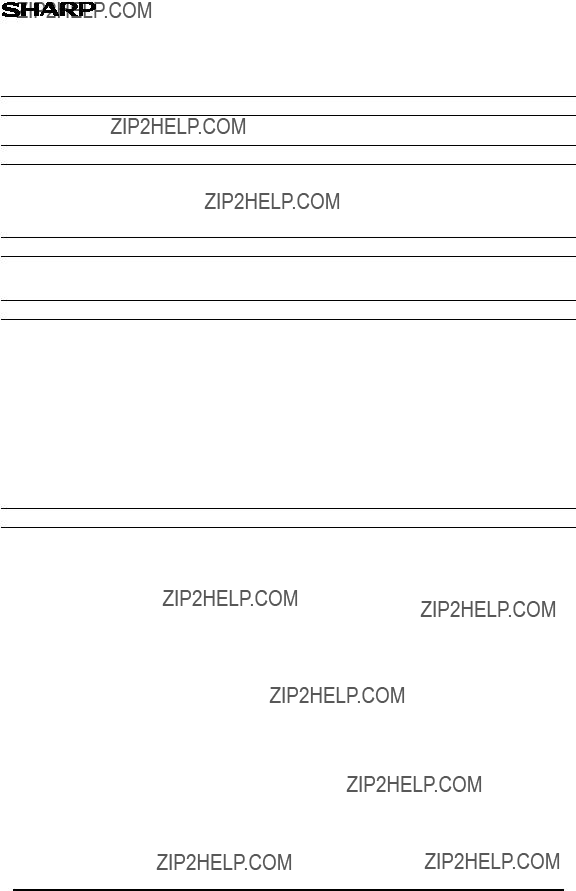
Data Revised: Jul .31, 2002
Data Issued: Jun. 1, 1998
MSDS NO.
12.ECOLOGICAL INFORMATION
No data are available.
13.DISPOSAL CONSIDERATION
Waste from residues :Waste material may be dumped or incinerated under conditions
which meet all federal, state and local environmental regulations. Contaminated Packaging :Waste may be disposed or incinerated under conditions which meet
all federal, state and local environmental regulations.
14. TRANSPORT INFORMATION
UN Classification :None
Not classified as hazardous for transport.
15.REGULATORY INFORMATION
US Information
TSCA (Toxic Substances Control Act) :
All chemical substances in this product comply with all applicable rules or order under TSCA.
SARA (Superfund Amendments and Reauthorization Act) Title III
16. OTHER INFORMATION
References
IARC (1996) :IARC monographs on the Evaluation of the Carcinogenic Risk of Chemicals to Humans, Vol. 65, Printing Process And Printing Inks, Carbon Black and Some Nitro Compounds, Lyon,
H.Muhle, B.Bellmann, O.Creutzenberg, C.Dasenbrock, H.Ernst, R.Kilpper, J.C.MacKenzie, P.Morrow, U.Mohr,
S.Takenaka, and R.Mermelstein (1991) Pulmonary Response to Toner upon Chronic Inhalation Exposure in Rats.
Fundamental and Applied Toxicology 17,
The information on this data sheet represents our current data and best opinion as to the proper use in handling of this product under normal conditions. However, all materials may present unknown hazards and should be used with caution. Although certain hazards are described herein, we do not guarantee that these are the only hazards which exist.
105

INDEX
Symbols
2
A
B
C
106

O
P
107

108

INDEX BY PURPOSE
Troubleshooting and maintenance
109
MEMO
MEMO


VAROITUS!
LAITTEEN K??YTT??MINEN
MUULLA KUIN T??SS??
K??YTT??OHJEESSA MAINITULLA
TAVALLA SAATTAA ALTISTAA
K??YTT??J??N
TURVALLISUUSLUOKAN 1
YLITT??V??LLE
N??KYM??TT??M??LLE
LASERS??TEILYLLE.
VARNING
OM APPARATEN ANV??NDS P??
ANNAT S??TT ??N I DENNA
BRUKSANVISNING
SPECIFICERATS, KAN
ANV??NDAREN UTS??TTAS F??R
OSYNLIG LASERSTR??LNING,
SOM ??VERSKRIDER GR??NSEN
F??R LASERKLASS 1.
LUOKAN 1 LASERLAITE
KLASS 1 LASERAPPARAT
CLASS 1
LASER PRODUCT
LASER KLASSE 1

PRINTED IN FRANCE
TINSE1232TSZZ